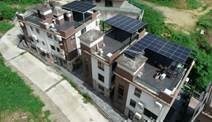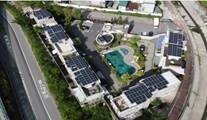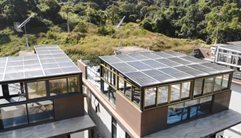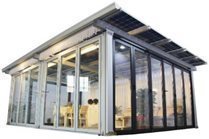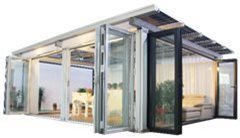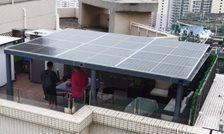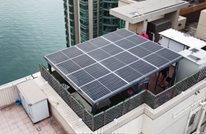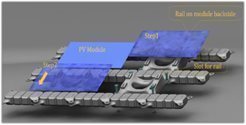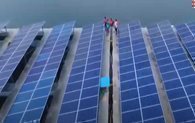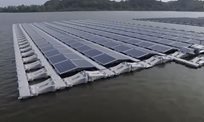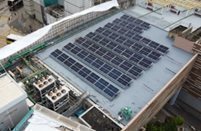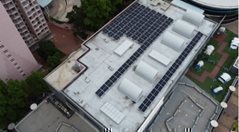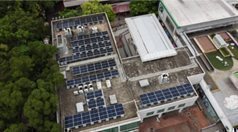Attached files
| file | filename |
|---|---|
| EX-32.2 - CERTIFICATION - Folkup Development Inc. | fldi_ex322.htm |
| EX-32.1 - CERTIFICATION - Folkup Development Inc. | fldi_ex321.htm |
| EX-31.2 - CERTIFICATION - Folkup Development Inc. | fldi_ex312.htm |
| EX-31.1 - CERTIFICATION - Folkup Development Inc. | fldi_ex311.htm |
| EX-21.1 - SUBSIDIARIES OF REGISTRANT - Folkup Development Inc. | fldi_ex211.htm |
UNITED STATES
SECURITIES AND EXCHANGE COMMISSION
WASHINGTON, D.C. 20549
FORM 10-K
ANNUAL REPORT PURSUANT TO SECTION 13 OR 15(D) OF
THE SECURITIES EXCHANGE ACT OF 1934
For the fiscal year ended December 31, 2020
Commission File No. 333-216921
| FOLKUP DEVELOPMENT INC. |
| (Exact name of registrant as specified in its charter) |
| Nevada | 32-0499929 | |
| (State or other jurisdiction of | (I.R.S. Employer | |
| incorporation or organization) | Identification No.) |
Unit 17-18, 23/F, Metropole Square
2 On Yiu Street, Sha Tin
New Territories, Hong Kong
(Address of principal executive offices, zip code)
+852 3487-6330
(Registrant’s telephone number, including area code)
____________________________________________________________
(Former name, former address and former fiscal year, if changed since last report)
Securities registered pursuant to Section 12(b) of the Act:
| Title of each class | Trading Symbol(s) | Name of each exchange on which registered |
|
|
|
|
SECURITIES REGISTERED PURSUANT TO SECTION 12(G) OF THE ACT:
Common Stock, $.001 Par Value
Indicate by check mark if the registrant is a well-known seasoned issuer, as defined in Rule 405 of the Securities Act. Yes ☐ No ☒
Indicate by check mark if the registrant is not required to file reports pursuant to Section 13 or Section 15(d) of the Act. Yes ☐ No ☒
Indicate by check mark whether the registrant (1) has filed all reports required to be filed by Section 13 or 15(d) of the Securities Exchange Act of 1934 during the preceding 12 months (or for such shorter period that the registrant was required to file such reports), and (2) has been subject to such filing requirements for the past 90 days. Yes ☒ No ☐
Indicate by check mark whether the registrant has submitted electronically every Interactive Data File required to be submitted pursuant to Rule 405 of Regulation S-T (§ 232.405 of this chapter) during the preceding 12 months (or for such shorter period that the registrant was required to submit such files). Yes ☒ No ☐
Indicate by check mark whether the registrant is a large accelerated filer, an accelerated filer, a non-accelerated filer, a smaller reporting company, or an emerging growth company. See the definitions of “large accelerated filer,” “accelerated filer,” “smaller reporting company,” and “emerging growth company” in Rule 12b-2 of the Exchange Act.
| Large accelerated filer | ☐ | Accelerated filer | ☐ |
| Non-accelerated filer | ☒ | Smaller reporting company | ☒ |
|
|
| Emerging growth company | ☒ |
If an emerging growth company, indicate by check mark if the registrant has elected not to use the extended transition period for complying with any new or revised financial accounting standards provided pursuant to Section 13(a) of the Exchange Act. ☒
Indicate by check mark whether the registrant has filed a report on and attestation to its management’s assessment of the effectiveness of its internal control over financial reporting under Section 404(b) of the Sarbanes-Oxley Act (15 U.S.C. 7262(b)) by the registered public accounting firm that prepared or issued its audit report. ☐
Indicate by check mark whether the registrant is a shell company (as defined in Rule 12b-2 of the Exchange Act). Yes ☐ No ☒
At June 30, 2020, the last business day of the Registrant’s most recently completed second fiscal quarter, the aggregate market value of the voting common stock held by non-affiliates of the Registrant (without admitting that any person whose shares are not included in such calculation is an affiliate) was approximately $31,233,171.
As of March 25, 2021, there were 9,800,000 shares of the Registrant’s common stock, par value $0.001 per share, outstanding.
FOLKUP DEVELOPMENT INC.
| 2 |
| Table of Contents |
FORWARD-LOOKING STATEMENTS
This Annual Report on Form 10-K of Folkup Development Inc., a Nevada corporation (the “Company”), contains “forward-looking statements,” as defined in the United States Private Securities Litigation Reform Act of 1995. In some cases, you can identify forward-looking statements by terminology such as “may”, “will”, “should”, “could”, “expects”, “plans”, “intends”, “anticipates”, “believes”, “estimates”, “predicts”, “potential” or “continue” or the negative of such terms and other comparable terminology. These forward-looking statements include, without limitation, statements about our market opportunity, our strategies, competition, expected activities and expenditures as we pursue our business plan, and the adequacy of our available cash resources. Although we believe that the expectations reflected in the forward-looking statements are reasonable, we cannot guarantee future results, levels of activity, performance or achievements. Actual results may differ materially from the predictions discussed in these forward-looking statements. The economic environment within which we operate could materially affect our actual results. Additional factors that could materially affect these forward-looking statements and/or predictions include, among other things: (i) commercialization of our technology and products, (ii) development and protection of our intellectual property, (iii) the Company’s need for and ability to obtain additional financing, (iv) industry competition, (v) the exercise of the control over us by Hak Yiu Ng, the Company’s President and Chairman of the Board of Directors, and majority shareholder, (vi) other factors over which we have little or no control; and (vii) other factors discussed in the Company’s filings with the Securities and Exchange Commission (“SEC”).
Our management has included projections and estimates in this Form 10-K, which are based primarily on management’s experience in the industry, assessments of our results of operations, discussions and negotiations with third parties and a review of information filed by our competitors with the SEC or otherwise publicly available. We caution readers not to place undue reliance on any such forward-looking statements, which speak only as of the date made. We disclaim any obligation subsequently to revise any forward-looking statements to reflect events or circumstances after the date of such statements or to reflect the occurrence of anticipated or unanticipated events.
| 3 |
| Table of Contents |
DESCRIPTION OF BUSINESS
Our Corporate History and Background
The Company was incorporated on July 5, 2016, under the laws of the State of Nevada.
On June 26, 2020, Milena Topolac Tomovic, the then major shareholder, entered into a Stock Purchase Agreement with Hak Yiu Ng, wherein Milena Topolac Tomovic sold 3,000,000 shares of the Company’s common stock, then representing approximately 78.9% of all issued and outstanding shares of common stock, to Mr. Ng.
Milena Topolac Tomovic served as President, Secretary, Treasurer and a director from July 5, 2016 until her resignation on July 6, 2020. Effective from July 6, 2020, Milena Topolac Tomovic resigned as a director, and from the offices of President, Secretary and Treasurer of, the Company. Immediately prior to such resignation, Ms. Topolac Tomovic, as the sole member of the board of directors at such time, appointed Hak Yiu Ng as a director, and as President, Secretary and Treasurer of the Company. Mr. Ng was the Company’s sole officer and director until November 25, 2020.
On November 25, 2020, Hak Yiu Ng resigned as Secretary and was appointed Chairman of the Board of Directors of the Company. On November 25, 2020, Huang Zhen Kun was appointed Chief Executive Officer and a Director; Lau Kit Yan, Mark was appointed Chief Financial Officer, Secretary and a Director; Poon To Ming was appointed Chief Operating Officer; Wong Ka Hing Andrew was appointed Chief Marketing Officer; and Xu Ming was appointed Chief Technology Officer.
The Company does not have any current plans, arrangements, discussions or intentions, whether written or oral, to engage in a merger or acquisition with an identified or unidentified company or person to be used as a vehicle for a private company to become a reporting company.
From inception until we completed our reverse acquisition of Powertech Holdings, the principal business of the Company was a plan to establish a business to lease and sell certain items or means of what we referred to as eco-transport. These items are commonly known under the names: a Segway, a gyro-scooter or a self-balanced two-wheeled scooter, a self-balanced mono-wheeled scooter and a two-wheeled hoverboard. We expected our products and services to be demanded by establishments or enterprises or events, for instance, conferences held in large facilities, or touristic agencies and other establishments or organizations that face the problem of covering large distances by employees or visitors of theirs.
| 4 |
| Table of Contents |
Reverse Acquisition of Powertech Holdings
On November 25, 2020, the Company entered into a Share Exchange Agreement (the “Share Exchange Agreement”), by and among the Company, Powertech Holdings Company Limited, a British Virgin Islands corporation (“Powertech Holdings”), and the holders of common shares of Powertech Holdings. The holders of the common stock of Powertech Holdings consisted of 48 stockholders.
Under the terms and conditions of the Share Exchange Agreement, the Company offered, sold and issued 6,000,000 shares of common stock in consideration for all the issued and outstanding shares in Powertech Holdings. Hak Yiu Ng, the Company’s sole officer and director, is the beneficial holder of 4,000,000 common shares, or 76.8%, of the issued and outstanding shares of Powertech Holdings. The effect of the issuance of the 6,000,000 shares issued under the Share Exchange Agreement is that the former shareholders of Powertech holdings acquired 61.2% of the issued and outstanding shares of common stock of the Company.
Immediately prior to the closing of the transactions under the Share Exchange Agreement, Mr. Ng was the holder of 3,000,000 shares of common stock, or 78.9%, of the issued and outstanding shares of common stock of the Company. Giving effect to the closing of the transactions under the Share Exchange Agreement, Mr. Ng acquired 4,607,408 shares of common stock of the Company, by virtue of his 76.8% beneficial ownership of Powertech Holdings. The remaining 47 common shareholders of Powertech Holdings acquired 1,392,592 shares of common stock under the Share Exchange Agreement, by virtue of their aggregate of 23.2% beneficial ownership of Powertech Holdings.
Giving effect to the transactions under the Share Exchange Agreement, Mr. Ng is now the beneficial holder of 7,607,408 shares of common stock, or 77.6%, of the issued and outstanding shares of common stock of Powertech Holdings.
As a result of the share exchange, Powertech Holdings is now a wholly-owned subsidiary of the Company.
The share exchange transaction with Powertech Holdings was treated as a reverse acquisition, with Powertech Holdings as the acquirer and the Company as the acquired party. Unless the context suggests otherwise, when we refer in this Form 8-K to business and financial information for periods prior to the consummation of the reverse acquisition, we are referring to the business and financial information of Powertech Holdings.
On November 25, 2020, the Company’s Board of Directors approved a change in its fiscal year end from November 30 to December 31, effective beginning with the Company’s next fiscal year, which will now begin on January 1, 2021 and end on December 31, 2021 (the “New Fiscal Year”).
Organization & Subsidiaries
We have seven operating subsidiaries, and our organizational structure is as follows:
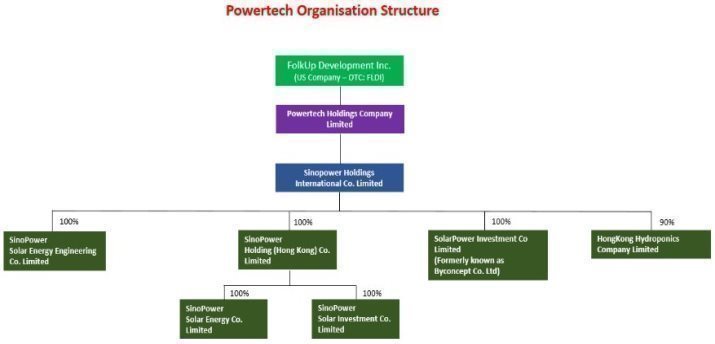
| 5 |
| Table of Contents |
Overview of Powertech Holdings
Our wholly owned subsidiary, Powertech Holdings was incorporated on September 21, 2020, in the British Virgin Islands.
The business of Powertech Holdings is now the principal business of the Company. Powertech Holdings is organized, through its subsidiaries, to provide renewable energy products and solutions to customers in Hong Kong.
Powertech Holdings principal administrative offices are located at Unit 17-18, 23/F, Metropole Square, 2 On Yiu Street, Sha Tin, New Territories, Hong Kong, and our telephone number is +852 3487-6330. Our website is www.sinopowersolar.com.hk.
Summary Financial Information
The tables and information below are derived from our audited consolidated financial statements as of December 31, 2020 and 2019.
|
|
| December 31, 2020 |
|
| December 31, 2019 |
| ||
| Financial Summary |
|
|
|
|
|
| ||
| Cash and Cash Equivalents |
| $ | 160,594 |
|
| $ | 243,641 |
|
| Total Assets |
|
| 3,582,437 |
|
|
| 1,323,107 |
|
| Total Liabilities |
|
| 5,139,803 |
|
|
| 1,970,017 |
|
| Total Stockholders’ Deficit |
| $ | 1,557,366 |
|
| 646,910 |
| |
Renewable Energy Segment in Hong Kong
Hong Kong is one of the most densely-populated regions in the world. According to the Census and Statistics Department of the Hong Kong SAR Government, the population of Hong Kong is estimated to be 7.52 million in mid-2019. The large population results in a serious energy demand in modern life.
Renewable energy (“RE”) is one of practical and affordable solutions to the energy needs in Hong Kong. According to the International Renewable Energy Agency, renewables could supply 80% of the world’s electricity by 2050. Although Hong Kong does not have favorable conditions for large-scale commercialized RE power generation, the government has applied RE on a wider and large scale by 2030 as according to the Hong Kong’s Climate Action Plan. Based on the currently mature and commercially available technologies, Hong Kong has about 3-4% of realizable RE potential arising from solar energy. The Hong Kong government spearhead to apply RE in a systematic manner, issue its environmental policy by specifying all new government buildings to have at least 10% rooftop space to install solar power system, while set up a strong budget to do retrofit work for all existing government and public buildings to install rooftop solar power system.
| 6 |
| Table of Contents |
The Paris Agreement an ambitious multilateral treaty agreed in December 2015, succeeds the Kyoto Protocol that will expire in 2020. Hong Kong formally signed it on Earth Day, 22 April 2016, and the Paris Agreement came into force on 4th November 2016.
The key provisions of the Paris Agreement call for global actions to - achieve “peak” greenhouse gas (GHG) emissions as soon as possible and achieve a balance between carbon sources and sinks in the second half of the 21st century (i.e. to reach “carbon neutrality” between 2051 and 2100); and, keep global average temperature increase well below 2 degree relative to pre-industrial levels and to pursue efforts to limit it to 1.5 degree
To meet the requirement of the Paris Agreement, Hong Kong has set an ambitious carbon intensity target of 65% to 70% by 2030 using 2005 as the base, which is equivalent to 26% to 36% absolute reduction and a reduction to 3.3-3.8 tonnes on a per capita basis.
Our Product Portfolio
We invest, supply and install rooftop and greenfield solar system, and hydroponics farms. We license technology underlying patents for our following solar and hydroponic farming products:
1. Rooftop Solar Pergola for village houses (China Patent No. 2019202902287)
A solar pergola using 20 pcs of mono-crystaline solar panels mounted on resilient, high-tensile tempered aluminium structures, 2.5 m high pergoa which meets structural requirement of the Building Code, sustain the strongest typhoon wind load, rust-free and durable, free from daily maintenance. The law allows property owner of village house to use its 350 sq. ft rooftop space for solar power creation. This Rooftop Solar Pergola perfectly meets the need of the village house owners.
|
|
|
|
|
|
|
|
Video links:
https://www.youtube.com/watch?v=zqG_QoRnR1M
https://www.youtube.com/watch?v=xxmFHB3xszY
| 7 |
| Table of Contents |
2. Rooftop Solar Glasshouse (Hong Kong Patent No. HK1258743)
A solar glasshouse, architect designed to meet the legal requirement of 2.5 meters high, with detachable wind shield and windows, using 20 mono crystaline solar panels mounted on resilient and high-tensile tempered aluminium structures, sustains the strongest wind load test, and can be easily detached and removed when relocation is needed. It offers perfect extra rooftop space for village house owners, and creates great value for house owners especially in such a densely populated city of Hong Kong. A 350 sq.ft house in Hong Kong can easily cost people HKD4 mil (USD 510,000), and we offer to market only HKD 150,000.
|
|
|
|
|
|
|
|
Video links:
https://www.youtube.com/watch?v=wtPABRl3v_E
3. Wheelset Solar Carport (China Patent No. 2018211576333)
Movable solar carport with wheels on the pillars, which allows end users to easily move and locate the carports to place as he needs, and at the same time get the best optimal sunshine for solar power harvest. With high efficient mono-crystaline solar panels on resilient and high-tensile tempered aluminium structure, it sustains strongest monsoon wind load, and at the same time require minimum daily maintenance.
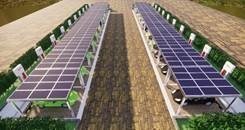
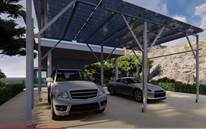
Video links:
https://www.youtube.com/watch?v=QrlN1krWuUg
https://www.youtube.com/watch?v=JDPkK2NnE8M
https://www.youtube.com/watch?v=SU9yG7P5JKQ
| 8 |
| Table of Contents |
4. Retractile Solar Carport (China Patent No. 201821962427X)
Aluminum alloyed retractile solar carpark pergola, with resilient aluminum structure, designed to let end users extend and retract one side of the carport to allow best utilization of space in densely populated city like Hong Kong, Japan and Singapore. The pergola can be easily moved and located to any place needed. It can be used in combination with Tesla’s energy storage device and EV charging station. It is perfect for end users who own temporarily idle land space.
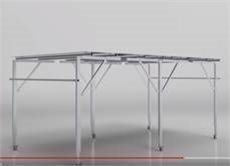
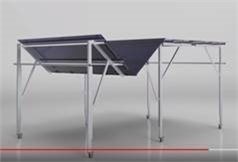
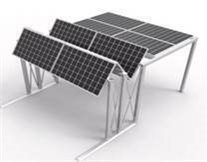
5. UND (Up-N-Down) Solar Pergola (China Patent No. 2019212562934)
It is a solar pergola with built in motor lifter on each pillars that, allows end users to lift and lower the solar pergola levels when needed. It is perfect for the rooftop owners of very high buildings and of houses near the seashore where monsoon wind can be an issue in typhoon season. The solar pergola can be lowered down to about 1.5 m when typhoon is expected, and be lifted to 2.5 m high in normal days, by simple button press.
|
|
6. Hydroponic Solar Greenhouse (patent pending)
Specially designed hydroponic farming greenhouse, with 60% rooftop solar coverage for energy production. PERC Bifacial Mono-crystaline solar panels are installed on the greenhouse rooftop, leaving about 40% space for sunlight to penetrate to the hydroponic farming floor for crop lighting. Energy Storage device can be installed to harvest solar power in day time for use at night, by so doing, crops can be grown in expedited way by using solar powered LED lighting at night.
|
|
| 9 |
| Table of Contents |
6. Tracker-run Solar Greenhouse (patent pending)
Solar greenhouse with solar tracker, where a computer programmed motor run tracking mechanism is built in to the rooftop structure, whereas the solar panels rotates according to the sun’s track, maintaining always 90 degree angle facing the sun, maximizing solar irradiation harvest which results in much higher solar power yield than conventional mounting structure. Power output is 15% higher than fixed tilt structural greenhouse. The motor is programmed in such a manner that, during typhoon day, it turns flat to avoid wind load, while when it rains, it rotates continuous to do auto-cleaning of the solar panels.
This product is denoted by the following features:
|
| · | The optimum tracking angle is calculated using highly precise astronomical equations based on time, longitude and latitude information from a GPS sensor; |
|
|
|
|
|
| · | The current tilt angle is obtained from a sensor (e.g. an inclinometer); and |
|
|
|
|
|
| · | By coordinating the two angles, the control system instructs the tracking mounting system to follow the sun throughout the day, which increases the total amount of electrical energy produced. |


7. RPP Solar Foundation (Hong Kong Patent No. HK1258742)
Using Recyclable PP material, die cast solar bucket is an ideal solar foundation that makes flat rooftop solar installation easy and quick. The RPP solar foundation past all static wind tunnel test that sustains strong typhoon wind pressure, and it flexible, durable and movable. It is highly recommended by all architect as the best rooftop solar solution in cities like Hong Kong, Singapore, Tokyo and Taipei. Using RPP solar foundation, a 10 days rooftop solar installation can be done within 2 days.
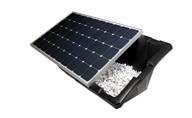
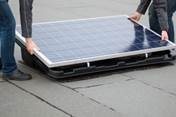
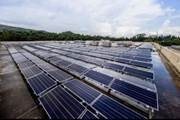
Video links:
https://www.youtube.com/watch?v=U5j9ccLN9Y8&t=28s
https://www.youtube.com/watch?v=26so7RDdKxE
| 10 |
| Table of Contents |
8. Off-grid Flexible Solar Panel Solution for RV and Yachts:
Flexible Mono-crystaline solar panels, packed with hybrid inverter and battery which can be conveniently used to power cars, yacht, vans, or simply outdoor picnic cars. This is a very popular product lines in coastal cities as Hong Kong, Singapore, Kuala Lumpur, Tokyo, etc.


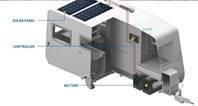
9. HDPE Floating Solar Deck:
For fishing ponds and water reservoir, HDPE Floating Solar Deck allows solar panels to be laid over the water surface, where solar panels creates solar power, and protect pond fish and prawns from direct sunshine. It helps making water conservation and at the same time making environmental protection of prohibiting over weeding on the fish ponds.
|
|
|
|
Our Main Projects:
We actively participate the renewable energy-related projects, as follows:
EMSD (Electrical and Mechanical Services Department) of Hong Kong Government is responsible to make retrofit work with solar on-grid solution in all 1200 schools, 1500 public toilets, and over 300 public housing estates in Hong Kong. The government as set up a HKD 800 million budget to setup rooftop solar power system in all government buildings and public housing buildings. Powertech’s subsidiary business vehicle, Sinopower Group has installed rooftop solar power system in 68 schools so far, and is planned to continue building 1200 school rooftop solar power systems in the next 18 months.
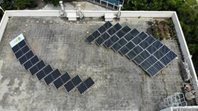
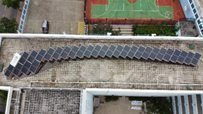
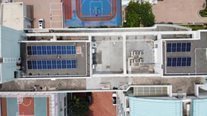
Link Real Estate Investment Trust (“Link REIT”) is the first real estate investment trust listed in Hong Kong, and currently Asia’s largest REIT and one of the world’s largest retail focused REITs in terms of market capitalization. Wholly owned by private and institutional investors, with 100% free float, Spanning Hong Kong, Beijing, Shanghai and Guangzhou, the portfolio owned by Link REIT consists of properties with about 9 million sq ft of retail space, around 61,000 car park spaces, and a multi-purpose project under development in Hong Kong, as well as properties with about 3 million sq ft of retail and office space in Mainland China. It is the desire of Link to make use the currently un-utilized rooftop space to install solar power system to serve the community with clean energy.
| 11 |
| Table of Contents |
Link Asset Management Limited (“Link Asset Management”), (“Link”; Hong Kong stock code: 823), announced that it successfully priced its green convertible bonds (the “Bonds”) due 2024, raising HK$4 billion at 1.6% p.a., the lowest coupon rate achieved by Asian REITs over the past five years. Underscoring Link’s commitment to sustainable development, the green convertible bond issue marks the first ever green convertible bond globally in the real estate sector and for Hong Kong issuers. Link is committed to build in all the shopping malls rooftop solar power system. And so far, Powertech have completed 3 projects for LINK.
|
|
|
|
Our Business model and Business Strategy:
EPC (Engineer, Procurement and Construction): For government and for pseudo-government organisations, and some of the industrial clients who owns industrial and commercial builders, we offer one stop solution of EPC services, whereas we design, engineer, procure, and install solar power system for the clients on BOT basis. Our business strategy for these group of clients is to offer full set of value added service, not only doing solar power system installation, but also service like water-proof works, building repairing works. This distinguished us from our competitors that, we carry out waterproof work on the Premises before installing the System by laying over an aluminium foil waterproof asphalt self-adhesive membrane (asphalt base/butyl/ rubber group) to the entire roof of each of the Buildings up to 300mm of the parapet wall. The asphalt self adhesive membrane stop water leakage problem and at the same time act as reflective layer for solar irradiation to back sides of bi-facial solar panels, which result in higher solar yield. We tailor made all solar mounting system of each project to meet the stringent demand of the legal wind code, making third party wind tunnel test to make sure the system is safe and durable.
Since the fourth quarter of 2020, we have developed and built the solar plant system and generated some income from the sale of the electricity under the government program.
Intellectual Property
Our primary patents, all of which are registered in Hong Kong or China, are discussed under the heading “Exclusive Patent License Agreements,” beginning on page 4 of this Current Report on Form 8-K. Additionally, we rely on a combination of trademark laws, trade secrets, confidentiality provisions and other contractual provisions to protect our proprietary rights, which are primarily our brand names, product designs and marks.
Exclusive Patent License Agreements
Effective November 25, 2020, the Company entered into an Exclusive Patent License Agreement with Fushan Baohua Renewable Energy Co Ltd (PRC) (“Fushan Baohua”), an entity duly formed and existing under the laws of the People’s Republic of China (the “Fushan Baohua License Agreement”), pursuant to which the Company has licensed from Fushan Baohua the patents for the technology underlying Liftable Soar Pergola, Expandable Soar Pergola and Foldable Solar Pergola products of the Company. The term of the Fushan Baohua License Agreement is for the terms of the underlying patents and covers all countries and territories in the world. The Liftable Soar Pergola patent expires on August 5, 2029, the Expandable Soar Pergola patent expires on August 2, 2029, and the Foldable Solar Pergola patent expires on August 2, 2029. The Company paid consideration of $10.00 for entering into the Fushan Baohua License Agreement. Fushan Baohua is controlled by Hak Yiu Ng, the President, Chairman of the Board of Directors and majority stockholder of the Company.
| 12 |
| Table of Contents |
Effective November 25, 2020, the Company entered into an Exclusive Patent License Agreement with PowerWatt Engineering Co. Ltd. (“PowerWatt Engineering”), an entity duly formed an existing under the laws of Hong Kong, (the “PowerWatt Engineering License Agreement”), pursuant to which the Company has licensed from PowerWatt Engineering the patents for the technology underlying the Foldable Solar Pergola, The Solar Photovoltaic Sunlight House, and RPP Ballast Solar System products of the Company. The term of the PowerWatt Engineering License Agreement is for the terms of the underlying patents and covers all countries and territories in the world. The Foldable Solar Pergola patent expires on November 26, 2028, the Solar Photovoltaic Sunlight House patent registered in China expires on March 7, 2029, and registered in Hong Kong expires on August 2, 2027, and the RPP Ballast Solar System registered in China expires on March 7, 2029, and registered in Hong Kong expires on August 5, 2027. The Company paid consideration of $10.00 for entering into the PowerWatt Engineering License Agreement. PowerWatt Engineering is controlled by Hak Yiu Ng, the President, Chairman of the Board of Directors and majority stockholder of the Company.
Competition
We believe that there are about 20 market competitors with business in Hong Kong, but by registered capital, we are largest, and now about 30% of total market share. Some of our major competitors are: Nefin Solar Asset Limited, Amosolar Limited, CLP Energy Services (Holding) Limited, and Widex Solar Energy Technology Limited.
Government Regulation and Approvals
We are subject to the general laws in Hong Kong and China governing businesses including labor, occupational safety and health, general corporations, intellectual property and other similar laws.
Product liability claims may arise if any of our solar and hydroponic products have a harmful effect on a consumer, who may make a claim for damages or compensation as an injured party. The General Principles of the Civil Law of HKSAR, states that manufacturers and sellers of defective products causing property damage or injury shall incur civil liabilities for such damage or injuries.
We are subject to a number of local laws and regulations that involve matters such as privacy, rights of publicity, data protection, content regulation, intellectual property, competition, protection of minors, consumer protection, taxation or other subjects. Many of these laws and regulations are still evolving and being tested in courts and could be interpreted in ways that could harm our business. In addition, the application and interpretation of these laws and regulations often are uncertain, particularly in the new and rapidly evolving industry in which we operate.
Employees
As of the date hereof, we have 30 full-time employees.
Description of Properties
Our executive offices are located at Unit 17-18, 23/F, Metropole Square, 2 On Yiu Street, Sha Tin, New Territories, Hong Kong, and our telephone number is +852 3487-6330. We do not own any real estate or other physical properties.
Bankruptcy or Similar Proceedings
We have never been subject to bankruptcy, receivership or any similar proceeding.
As a “smaller reporting company,” as defined in Rule 12b-2 of the Exchange Act, we are not required to provide the information called for by this Item.
ITEM 1B. UNRESOLVED STAFF COMMENTS
None.
We currently do not own any physical property or real property. Our executive offices are located at Unit 17-18, 23/F, Metropole Square, 2 On Yiu Street, Sha Tin, New Territories, Hong Kong. We believe that this space is adequate for our present operations.
There are no pending legal proceedings to which the Company is a party or in which any director, officer or affiliate of the Company, any owner of record or beneficially of more than 5% of any class of voting securities of the Company, or security holder is a party adverse to the Company or has a material interest adverse to the Company.
ITEM 4. MINE SAFETY DISCLOSURES
None.
| 13 |
| Table of Contents |
Since April 1, 2019, our common stock has been quoted on the OTCPink tier of the OTC Markets Group Inc., under the symbol “FLDI.” On September 22, 2020, the last day our common stock traded on the OTC Markets, the closing bid price on the OTCPink tier for our common stock was $6.00.
Holders
As of March 25, 2021, there were 9,800,000 shares of common stock issued and outstanding held by approximately 52 stockholders of record, and no shares of preferred stock or Series A Preferred Stock issued or outstanding.
Dividends
We have not declared any dividends and we do not plan to declare any dividends in the foreseeable future. There are no restrictions in our Articles of Incorporation or Bylaws that prevent us from declaring dividends. The Nevada Revised Statutes, however, prohibit us from declaring dividends where, after giving effect to the distribution of the dividend:
|
| · | we would not be able to pay our debts as they become due in the usual course of business; or |
|
| · | our total assets would be less than the sum of our total liabilities plus the amount that would be needed to satisfy the rights of stockholders who have preferential rights superior to those receiving the distribution, unless otherwise permitted under our Articles of Incorporation. |
Recent Sales of Unregistered Securities
There are no unreported sales of equity securities at December 31, 2020.
Securities Authorized for Issuance Under Equity Compensation Plans
We have not established any compensation plans under which equity securities are authorized for issuance.
Penny Stock Regulations
The SEC has adopted regulations that generally define “penny stock” to be an equity security that has a market price of less than $5.00 per share. Our Common Stock, when and if a trading market develops, may fall within the definition of penny stock and be subject to rules that impose additional sales practice requirements on broker-dealers who sell such securities to persons other than established customers and accredited investors (generally those with assets in excess of $1.00 million, or annual incomes exceeding $200,000 individually, or $300,000 million, together with their spouse).
For transactions covered by these rules, the broker-dealer must make a special suitability determination for the purchase of such securities and have received the purchaser’s prior written consent to the transaction. Additionally, for any transaction, other than exempt transactions, involving a penny stock, the rules require the delivery, prior to the transaction, of a risk disclosure document mandated by the SEC relating to the penny stock market. The broker-dealer also must disclose the commissions payable to both the broker-dealer and the registered representative, current quotations for the securities and, if the broker-dealer is the sole market-maker, the broker-dealer must disclose this fact and the broker-dealer’s presumed control over the market. Finally, monthly statements must be sent disclosing recent price information for the penny stock held in the account and information on the limited market in penny stocks. Consequently, the “penny stock” rules may restrict the ability of broker-dealers to sell our Common Stock and may affect the ability of investors to sell their Common Stock in the secondary market.
| 14 |
| Table of Contents |
Purchases of Equity Securities by the Registrant and Affiliated Purchasers
We did not purchase any of our shares of common stock or other securities during the year ended December 31, 2020.
ITEM 6. SELECTED FINANCIAL DATA
As a “smaller reporting company,” as defined in Rule 12b-2 of the Exchange Act, we are not required to provide the information called for by this Item.
ITEM 7. MANAGEMENT’S DISCUSSION AND ANALYSIS OF FINANCIAL CONDITION AND RESULTS OF OPERATIONS
Comparison of the Years Ended December 31, 2020 and 2019
The following table sets forth certain operational data for the years indicated:
|
|
| Fiscal Years Ended December 31, |
| |||||
|
|
| 2020 |
|
| 2019 |
| ||
| Revenues, net |
| $ | 2,593,376 |
|
| $ | 2,150,997 |
|
| Cost of revenue |
|
| (2,050,375 | ) |
|
| (1,805,076 | ) |
| Gross profit |
|
| 543,001 |
|
|
| 345,921 |
|
| Sales and marketing expenses |
|
| (518,481 | ) |
|
| (267,126 | ) |
| General and administrative expenses |
|
| (947,507 | ) |
|
| (678,325 | ) |
| Total operating expenses |
|
| (1,465,988 | ) |
|
| (945,451 | ) |
| Total other income |
|
| 15,762 |
|
|
| 589 |
|
| Loss before income taxes |
|
| (907,225 | ) |
|
| (598,941 | ) |
| Income tax expense |
|
| - |
|
|
| - |
|
| Net loss |
|
| (907,225 | ) |
|
| (598,941 | ) |
Revenue. We generated revenues of $2,593,376 and $2,150,997 for the fiscal years ended December 31, 2020 and 2019. The increase is revenue is attributable to the completion of renewable energy projects and solutions during 2020, whose contracts were entered into during 2019.
During the twelve months ended December 31, 2020 and 2019, the following customer accounted for 10% or more of our total net revenues:
|
|
| Year ended December 31, 2020 |
|
| December 31, 2020 |
| ||||||
|
|
| Revenues |
|
| Percentage of revenues |
|
| Accounts receivable |
| |||
| Mak Hang Kei (HK) Construction Limited |
| $ | 901,643 |
|
|
| 35 | % |
| $ | 32,427 |
|
| Taclon Industries Limited |
|
| 504,093 |
|
|
| 19 | % |
|
| - |
|
|
|
|
|
|
|
|
|
|
|
|
|
|
|
| Total: |
| $ | 1,405,736 |
|
|
| 54 | % |
| $ | 32,427 |
|
|
|
| Year ended December 31, 2019 |
|
| December 31, 2019 |
| ||||||
|
|
| Revenues |
|
| Percentage of revenues |
|
| Accounts receivable |
| |||
| Hung Hing Off-Set Printing Co Ltd |
| $ | 336,080 |
|
|
| 16 | % |
| $ | - |
|
All of the Company’s major customers are located in Hong Kong.
| 15 |
| Table of Contents |
Cost of Revenue. Cost of revenue included material supplies, labor and sub-contractor fees, share of electricity revenue generated, and the costs of maintaining and operating the renewable energy assets. The increase of cost of revenue is attributable to the launch of renewable energy projects and solutions.
During the twelve months ended December 31, 2020 and 2019, the following vendors accounted for 10% or more of our total cost of revenues:
|
|
| Year ended December 31, 2020 |
|
| December 31, 2020 |
| ||||||
|
|
| Purchases |
|
| Percentage of purchases |
|
| Accounts payable |
| |||
| Press Metal International Technology Ltd |
| $ | 349,276 |
|
|
| 17 | % |
| $ | 487,948 |
|
|
|
| Year ended December 31, 2019 |
|
| December 31, 2019 |
| ||||||
|
|
| Purchases |
|
| Percentage of purchases |
|
| Accounts payable |
| |||
| Powerwatt Engineering Co. Ltd. |
| $ | 1,205,571 |
|
|
| 67 | % |
| $ | - |
|
All of the Company’s major vendors are located in Hong Kong and the People’s Republic of China.
Gross Profit. We achieved a gross profit of $543,001 and $345,921 for the fiscal years ended December 31, 2020 and 2019, respectively. The increase in gross profit is primarily attributable to the completion of renewable energy projects and solutions during 2019 fiscal year.
Sales and Marketing Expenses (“S&M”). We incurred S&M expenses of $518,481 and $267,126 for the fiscal years ended December 31, 2020 and 2019, respectively. The increase in G&A is primarily attributable to more marketing expense in the launch of our renewable energy projects and solutions.
General and Administrative Expenses (“G&A”). We incurred G&A expenses of $947,507 and $678,325 for the fiscal years ended December 31, 2020 and 2019, respectively. The increase in G&A is primarily attributable to more overheads and staff expense in the launch of our renewable energy projects and solutions.
Other Income (Expenses), net. We incurred net other income of $15,762 for the fiscal year ended December 31, 2020, as compared to a net income of $589 for the fiscal year ended December 31, 2019. Our net other income for the year ended December 31, 2020 and 2019 consisted primarily of government subsidy and interest income.
Income Tax Expense. We recorded income tax expense of $0 and $0 for the fiscal years ended December 31, 2020 and 2019. No income expense was incurred in both 2020 and 2019 fiscal years.
Net Loss. During the year ended December 31, 2020, we incurred a net loss of $907,225, as compared to $598,941 for the year ended December 31, 2019.
Liquidity and Capital Resources
As of December 31, 2020, we had cash and cash equivalents of $160,594, deposits, prepayments and other receivables of $1,031,566, purchase deposits of $1,800,332 and accounts and retention receivables of $83,169.
As of December 31, 2019, we had cash and cash equivalents of $243,641, accounts and retention receivables of $155,221, deposits, prepayments and other receivables of $95,999, and purchase deposits of $676,090.
We believe that our current cash and other sources of liquidity discussed below are adequate to support general operations for at least the next 12 months.
|
|
| Years Ended December 31, |
| |||||
|
|
| 2020 |
|
| 2019 |
| ||
| Net cash used in operating activities |
| $ | (1,116,411 | ) |
| $ | (214,421 | ) |
| Net cash used in investing activities |
|
| (349,992 | ) |
|
| (14,765 | ) |
| Net cash provided by financing activities |
|
| 1,386,804 |
|
|
| 302,180 |
|
Net Cash Used In Operating Activities.
For the year ended December 31, 2020, net cash used in operating activities was $1,116,411, which consisted primarily of a net loss of $907,225, offset by a decrease in accounts and retention receivables of $72,052, an increase in deposits, prepayments and other receivables of $935,567, an increase in purchase deposits of $1,124,242, an increase in contract liabilities of $600,213, a decrease in accrued liabilities and other payables of $22,906, and increase in accounts payables of $1,100,268, depreciation of plant and equipment of $18,340, depreciation of energy assets of $3,703 and depreciation of right-of-use assets of $78,953.
For the year ended December 31, 2019, net cash used by operating activities was $214,421, which consisted primarily of a net loss of $598,941, offset by an increase in accounts and retention receivables of $155,221, an increase in deposits, prepayments and other receivables of $76,502, an increase in purchase deposits of $316,669, an increase in contract liabilities of $845,549, an increase in accrued liabilities and other payables of $66,103, depreciation of plant and equipment of $6,073, depreciation of right-of-use assets of $11,818 and loss on disposal of plant and equipment of $3,369.
We expect to continue to rely on cash generated through financing from our existing shareholders and private placements of our securities, however, to finance our operations and future acquisitions.
| 16 |
| Table of Contents |
Net Cash Used In Investing Activities.
For the year ended December 31, 2020, net cash used in investing activities was $349,992, consisting primarily of purchases of plant and equipment of $61,052 and purchases of energy asset of $288,940.
For the year ended December 31, 2019, net cash used in investing activities was $14,765, consisting primarily of purchases of plant and equipment of $15,150 and proceeds from disposal of plant and equipment of $385.
Net Cash Provided By Financing Activities.
For the year ended December 31, 2020, net cash provided by financing activities was $1,386,804, consisting primarily of proceeds from bank and other borrowings of $768,941, advances from a director of $696,259 and payment of lease liabilities of $78,396.
For the year ended December 31, 2019, net cash provided by financing activities was $302,180, consisting primarily of advances from a director of $314,432 and payment of lease liabilities of $12,252.
Going Concern
The financial statements contain an explanatory paragraph expressing substantial doubt about our ability to continue operating as a going concern. The financial statements have been prepared “assuming that we will continue as a going concern,” which states that we will realize our assets and satisfy any liabilities and commitments in the ordinary course of business.
We will need to raise funds to fund our ongoing operational expenses. Additional funding will likely come from equity financing from the sale of our common stock. If we are successful in completing equity financing, existing shareholders will experience dilution of their interest in our Company. We do not have any financing arranged and we cannot provide investors with any assurance that we will be able to raise sufficient funding from the sale of our common stock to fund our 12-month plan of operation and ongoing operational expenses. In the absence of such financing, our business will likely fail. There are no assurances that we will be able to achieve further sales of our common stock or any other form of additional financing. If we are unable to achieve the financing necessary to continue our plan of operations, then we will not be able to continue our 12-month plan of operation and our business will fail.
Off-Balance Sheet Arrangements
We have no outstanding off-balance sheet guarantees, interest rate swap transactions or foreign currency contracts. We do not engage in trading activities involving non-exchange traded contracts.
Limited Business History; Need for Additional Capital
There is no historical financial information about the Company upon which to base an evaluation of our performance. We have not generated any revenues from our business. We cannot guarantee we will be successful in our business plans. Our business is subject to risks inherent in the establishment of a new business enterprise, including limited capital resources, possible delays in the exploration and/or development, and possible cost overruns due to price and cost increases in services. We have no intention of entering into a merger or acquisition within the next twelve months and we have a specific business plan and timetable to complete our 12-month plan of operation based on the success of the primary offering.
We anticipate that additional funding, if required, will be in the form of equity financing from the sale of our common stock. However, we cannot provide investors with any assurance that we will be able to raise sufficient funding from the sale of shares to fund additional expenditures. We do not currently have any arrangements in place for any future equity financing. Our limited operating history and our lack of significant tangible capital assets makes it unlikely that we will be able to obtain significant debt financing in the near future. If such financing is not available on satisfactory terms, we may be unable to continue or expand our business. Equity financing could result in additional dilution to existing shareholders.
| 17 |
| Table of Contents |
Summary of Significant Accounting Policies
| · | Basis of presentation |
These accompanying consolidated financial statements have been prepared in accordance with generally accepted accounting principles in the United States of America (“US GAAP”).
| · | Use of estimates and assumptions |
In preparing these consolidated financial statements, management makes estimates and assumptions that affect the reported amounts of assets and liabilities in the balance sheet and revenues and expenses during the years reported. Actual results may differ from these estimates.
| · | Basis of consolidation |
The consolidated financial statements include the financial statements of the Company and its subsidiaries. All significant inter-company balances and transactions within the Company have been eliminated upon consolidation.
| · | Cash and cash equivalents |
Cash and cash equivalents are carried at cost and represent cash on hand, demand deposits placed with banks or other financial institutions and all highly liquid investments with an original maturity of three months or less as of the purchase date of such investments.
| · | Accounts receivable |
Accounts receivable are recorded at the invoiced amount and do not bear interest, which are due within contractual payment terms, generally 30 to 90 days from completion of service. Credit is extended based on evaluation of a customer’s financial condition, the customer credit-worthiness and their payment history. Accounts receivable outstanding longer than the contractual payment terms are considered past due. Past due balances over 90 days and over a specified amount are reviewed individually for collectibility. At the end of fiscal year, the Company specifically evaluates individual customer’s financial condition, credit history, and the current economic conditions to monitor the progress of the collection of accounts receivables. The Company will consider the allowance for doubtful accounts for any estimated losses resulting from the inability of its customers to make required payments. For the receivables that are past due or not being paid according to payment terms, the appropriate actions are taken to exhaust all means of collection, including seeking legal resolution in a court of law. Account balances are charged off against the allowance after all means of collection have been exhausted and the potential for recovery is considered remote. The Company does not have any off-balance-sheet credit exposure related to its customers.
| · | Purchase deposits |
Purchase deposits represent deposit payments made to vendors for procurement, which are interest-free, unsecured and relieved against accounts payable when materials are received by the Company.
| • | Energy assets |
Energy assets consist of cost of materials, outside contract services, deposits and project development costs incurred in connection with the construction of renewable energy plants which owned by the Company. These amounts are capitalized and amortized to cost of revenues in the consolidated statements of operations on a straight-line basis over the terms of the related contracts.
Routine maintenance costs are expensed as incurred in the consolidated statements of operations to the extent that such maintenance do not extend the life of the asset.
| · | Plant and equipment |
Plant and equipment are stated at cost less accumulated depreciation and accumulated impairment losses, if any. Depreciation is calculated on the straight-line basis over the following expected useful lives from the date on which they become fully operational and after taking into account their estimated residual values:
|
|
| Expected useful lives |
|
| Office equipment |
| 5 years |
|
| Furniture and fixtures |
| 5 years |
|
| Leasehold improvements |
| 5 years |
|
Expenditures for repairs and maintenance are expensed as incurred. When assets have been retired or sold, the cost and related accumulated depreciation are removed from the accounts and any resulting gain or loss is recognized in the results of operations.
| 18 |
| Table of Contents |
| · | Impairment of long-lived assets |
In accordance with the provisions of ASC Topic 360, “Impairment or Disposal of Long-Lived Assets”, all long-lived assets such as energy assets and plant and equipment held and used by the Company are reviewed for impairment whenever events or changes in circumstances indicate that the carrying amount of an asset may not be recoverable. Recoverability of assets to be held and used is evaluated by a comparison of the carrying amount of an asset to its estimated future undiscounted cash flows expected to be generated by the asset. If such assets are considered to be impaired, the impairment to be recognized is measured by the amount by which the carrying amounts of the assets exceed the fair value of the assets.
| · | Revenue recognition |
The Company adopted Accounting Standards Codification (“ASC”) 606 – Revenue from Contracts with Customers” (“ASC 606”) as of January 1, 2020 using the modified retrospective method. This method allows the Company to apply ASC 606 to new contracts entered into after January 1, 2020, and to its existing contracts for which revenue earned through December 31, 2019 has been recognized under the guidance in effect prior to the effective date of ASC 606. The revenue recognition processes the Company applied prior to adoption of ASC 606 align with the recognition and measurement guidance of the new standard, therefore adoption of ASC 606 did not require a cumulative adjustment to opening equity.
Under ASC 606, a performance obligation is a promise within a contract to transfer a distinct good or service, or a series of distinct goods and services, to a customer. Revenue is recognized when performance obligations are satisfied and the customer obtains control of promised goods or services. The amount of revenue recognized reflects the consideration to which the Company expects to be entitled to receive in exchange for goods or services. Under the standard, a contract’s transaction price is allocated to each distinct performance obligation. To determine revenue recognition for arrangements that the Company determines are within the scope of ASC 606, the Company performs the following five steps:
|
| • | identify the contract with a customer; |
|
| • | identify the performance obligations in the contract; |
|
| • | determine the transaction price; |
|
| • | allocate the transaction price to performance obligations in the contract; and |
|
| • | recognize revenue as the performance obligation is satisfied. |
The Company recognizes revenue when or as it satisfies a performance by transferring a good or service to the customer at a point in time, generally upon the completion of the projects under fixed price contracts. Under these fixed price contracts, the Company receives an agreed-upon amount for providing products and services specified in the contract, a profit or loss is recognized depending on whether actual costs are more or less than the agreed upon amount. Revenue from the sale of electricity to an electricity supplier in Hong Kong is recognized at the time the electricity is supplied from the energy assets on the basis of periodic meter readings. Revenues are measured at the fair value of the consideration received or receivable, which is calculated based on the predetermined tariff established by the electricity supplier under certain government program.
Contract assets primarily relate to the Company’s rights to consideration for work completed but not billed as of the balance sheet date on contracts with customers. The contract assets are transferred to receivables when the rights become unconditional. The Company has contract assets on contracts that are generally long-term and have revenues that are recognized upon the completion.
Contract liabilities primarily related to billings and payments received in advance of revenue recognized. As of December 31, 2020 and 2019, the Company received cash consideration from customers before the performance obligations were satisfied.
| · | Cost of revenues |
Cost of revenues consists primarily of raw materials, the fees paid to contractors and labor costs, which are directly attributable to the construction of solar-related projects.
Cost of revenues also include the share of electricity revenue generated, and the costs of maintaining and operating the renewable energy assets which owned by the Company, including the depreciation charge.
| 19 |
| Table of Contents |
| · | Income taxes |
The Company adopted the ASC 740 Income tax provisions of paragraph 740-10-25-13, which addresses the determination of whether tax benefits claimed or expected to be claimed on a tax return should be recorded in the consolidated financial statements. Under paragraph 740-10-25-13, the Company may recognize the tax benefit from an uncertain tax position only if it is more likely than not that the tax position will be sustained on examination by the taxing authorities, based on the technical merits of the position. The tax benefits recognized in the consolidated financial statements from such a position should be measured based on the largest benefit that has a greater than fifty percent (50%) likelihood of being realized upon ultimate settlement. Paragraph 740-10-25-13 also provides guidance on de-recognition, classification, interest and penalties on income taxes, accounting in interim periods and requires increased disclosures. The Company had no material adjustments to its liabilities for unrecognized income tax benefits according to the provisions of paragraph 740-10-25-13.
The estimated future tax effects of temporary differences between the tax basis of assets and liabilities are reported in the accompanying balance sheets, as well as tax credit carry-backs and carry-forwards. The Company periodically reviews the recoverability of deferred tax assets recorded on its balance sheets and provides valuation allowances as management deems necessary.
| · | Uncertain tax positions |
The Company did not take any uncertain tax positions and had no adjustments to its income tax liabilities or benefits pursuant to the ASC 740 provisions of Section 740-10-25 for the years ended December 31, 2020 and 2019.
| · | Foreign currencies translation |
Transactions denominated in currencies other than the functional currency are translated into the functional currency at the exchange rates prevailing at the dates of the transaction. Monetary assets and liabilities denominated in currencies other than the functional currency are translated into the functional currency using the applicable exchange rates at the balance sheet dates. The resulting exchange differences are recorded in the consolidated statement of operations.
The reporting currency of the Company is United States Dollar (“US$”) and the accompanying consolidated financial statements have been expressed in US$. In addition, the Company is operating in Hong Kong and maintain its books and record in its local currency, Hong Kong Dollars (“HKD”), which is a functional currency as being the primary currency of the economic environment in which their operations are conducted. In general, for consolidation purposes, assets and liabilities of its subsidiary whose functional currency is not US$ are translated into US$, in accordance with ASC Topic 830-30, “ Translation of Financial Statement”, using the exchange rate on the balance sheet date. Revenues and expenses are translated at average rates prevailing during the period. The gains and losses resulting from translation of financial statements of foreign subsidiary are recorded as a separate component of accumulated other comprehensive income within the statements of changes in stockholder’s equity.
| · | Retirement plan costs |
Contributions to retirement plans (which are defined contribution plans) are charged to general and administrative expenses in the accompanying statements of operation as the related employee service is provided.
| · | Comprehensive income |
ASC Topic 220,“Comprehensive Income”, establishes standards for reporting and display of comprehensive income, its components and accumulated balances. Comprehensive income as defined includes all changes in equity during a period from non-owner sources. Accumulated other comprehensive income, as presented in the accompanying consolidated statements of changes in stockholders’ equity, consists of changes in unrealized gains and losses on foreign currency translation. This comprehensive income is not included in the computation of income tax expense or benefit.
| · | Segment reporting |
ASC Topic 280, “Segment Reporting” establishes standards for reporting information about operating segments on a basis consistent with the Company’s internal organization structure as well as information about geographical areas, business segments and major customers in consolidated financial statements. For the years ended December 31, 2020 and 2019, the Company operates in one reportable operating segment in project construction. Since the fourth quarter of 2020, the Company commenced the sale of electricity through the energy assets.
| · | Leases |
The Company adopted Topic 842, Leases (“ASC 842”), using the modified retrospective approach through a cumulative-effect adjustment and utilizing the effective date of January 1, 2020 as its date of initial application, with prior periods unchanged and presented in accordance with the previous guidance in Topic 840, Leases (“ASC 840”).
At the inception of an arrangement, the Company determines whether the arrangement is or contains a lease based on the unique facts and circumstances present. Leases with a term greater than one year are recognized on the balance sheet as right-of-use (“ROU”) assets, lease liabilities and long-term lease liabilities. The Company has elected not to recognize on the balance sheet leases with terms of one year or less. Operating lease liabilities and their corresponding right-of-use assets are recorded based on the present value of lease payments over the expected remaining lease term. However, certain adjustments to the right-of-use asset may be required for items such as prepaid or accrued lease payments. The interest rate implicit in lease contracts is typically not readily determinable. As a result, the Company utilizes its incremental borrowing rates, which are the rates incurred to borrow on a collateralized basis over a similar term an amount equal to the lease payments in a similar economic environment.
| 20 |
| Table of Contents |
In accordance with the guidance in ASC 842, components of a lease should be split into three categories: lease components (e.g. land, building, etc.), non-lease components (e.g. common area maintenance, consumables, etc.), and non-components (e.g. property taxes, insurance, etc.). Subsequently, the fixed and in-substance fixed contract consideration (including any related to non-components) must be allocated based on the respective relative fair values to the lease components and non-lease components.
Lease expense is recognized on a straight-line basis over the lease terms. Lease expense includes amortization of the ROU assets and accretion of the lease liabilities. Amortization of ROU assets is calculated as the periodic lease cost less accretion of the lease liability. The amortized period for ROU assets is limited to the expected lease term.
The Company has elected a practical expedient to combine the lease and non-lease components into a single lease component. The Company also elected the short-term lease measurement and recognition exemption and does not establish ROU assets or lease liabilities for operating leases with terms of 12 months or less.
| · | Net loss per share |
The Company calculates net loss per share in accordance with ASC Topic 260, “Earnings per Share.” Basic income per share is computed by dividing the net loss by the weighted-average number of common shares outstanding during the year. Diluted loss per share is computed similar to basic loss per share except that the denominator is increased to include the number of additional common shares that would have been outstanding if the potential common stock equivalents had been issued and if the additional common shares were dilutive.
| · | Related parties |
The Company follows the ASC 850-10, Related Party for the identification of related parties and disclosure of related party transactions.
Pursuant to section 850-10-20 the related parties include a) affiliates of the Company; b) entities for which investments in their equity securities would be required, absent the election of the fair value option under the Fair Value Option Subsection of section 825–10–15, to be accounted for by the equity method by the investing entity; c) trusts for the benefit of employees, such as pension and Income-sharing trusts that are managed by or under the trusteeship of management; d) principal owners of the Company; e) management of the Company; f) other parties with which the Company may deal if one party controls or can significantly influence the management or operating policies of the other to an extent that one of the transacting parties might be prevented from fully pursuing its own separate interests; and g) other parties that can significantly influence the management or operating policies of the transacting parties or that have an ownership interest in one of the transacting parties and can significantly influence the other to an extent that one or more of the transacting parties might be prevented from fully pursuing its own separate interests.
The consolidated financial statements shall include disclosures of material related party transactions, other than compensation arrangements, expense allowances, and other similar items in the ordinary course of business. However, disclosure of transactions that are eliminated in the preparation of consolidated or combined financial statements is not required in those statements. The disclosures shall include: a) the nature of the relationship(s) involved; b) a description of the transactions, including transactions to which no amounts or nominal amounts were ascribed, for each of the periods for which income statements are presented, and such other information deemed necessary to an understanding of the effects of the transactions on the financial statements; c) the dollar amounts of transactions for each of the periods for which income statements are presented and the effects of any change in the method of establishing the terms from that used in the preceding period; and d) amount due from or to related parties as of the date of each balance sheet presented and, if not otherwise apparent, the terms and manner of settlement.
| · | Commitments and contingencies |
The Company follows the ASC 450-20, Commitments to report accounting for contingencies. Certain conditions may exist as of the date the financial statements are issued, which may result in a loss to the Company but which will only be resolved when one or more future events occur or fail to occur. The Company assesses such contingent liabilities, and such assessment inherently involves an exercise of judgment. In assessing loss contingencies related to legal proceedings that are pending against the Company or un-asserted claims that may result in such proceedings, the Company evaluates the perceived merits of any legal proceedings or un-asserted claims as well as the perceived merits of the amount of relief sought or expected to be sought therein.
| 21 |
| Table of Contents |
If the assessment of a contingency indicates that it is probable that a material loss has been incurred and the amount of the liability can be estimated, then the estimated liability would be accrued in the Company’s consolidated financial statements. If the assessment indicates that a potentially material loss contingency is not probable but is reasonably possible, or is probable but cannot be estimated, then the nature of the contingent liability, and an estimate of the range of possible losses, if determinable and material, would be disclosed.
Loss contingencies considered remote are generally not disclosed unless they involve guarantees, in which case the guarantees would be disclosed. Management does not believe, based upon information available at this time that these matters will have a material adverse effect on the Company’s financial position, results of operations or cash flows. However, there is no assurance that such matters will not materially and adversely affect the Company’s business, financial position, and results of operations or cash flows.
| · | Fair value of financial instruments |
The Company follows paragraph 825-10-50-10 of the FASB Accounting Standards Codification for disclosures about fair value of its financial instruments and has adopted paragraph 820-10-35-37 of the FASB Accounting Standards Codification (“Paragraph 820-10-35-37”) to measure the fair value of its financial instruments. Paragraph 820-10-35-37 of the FASB Accounting Standards Codification establishes a framework for measuring fair value in generally accepted accounting principles (GAAP), and expands disclosures about fair value measurements. To increase consistency and comparability in fair value measurements and related disclosures, paragraph 820-10-35-37 of the FASB Accounting Standards Codification establishes a fair value hierarchy which prioritizes the inputs to valuation techniques used to measure fair value into three (3) broad levels. The fair value hierarchy gives the highest priority to quoted prices (unadjusted) in active markets for identical assets or liabilities and the lowest priority to unobservable inputs. The three (3) levels of fair value hierarchy defined by paragraph 820-10-35-37 of the FASB Accounting Standards Codification are described below:
| Level 1 |
| Quoted market prices available in active markets for identical assets or liabilities as of the reporting date. |
|
|
|
|
| Level 2 |
| Pricing inputs other than quoted prices in active markets included in Level 1, which are either directly or indirectly observable as of the reporting date. |
|
|
|
|
| Level 3 |
| Pricing inputs that are generally observable inputs and not corroborated by market data. |
Financial assets are considered Level 3 when their fair values are determined using pricing models, discounted cash flow methodologies or similar techniques and at least one significant model assumption or input is unobservable.
The fair value hierarchy gives the highest priority to quoted prices (unadjusted) in active markets for identical assets or liabilities and the lowest priority to unobservable inputs. If the inputs used to measure the financial assets and liabilities fall within more than one level described above, the categorization is based on the lowest level input that is significant to the fair value measurement of the instrument.
The carrying amounts of the Company’s financial assets and liabilities, such as cash and cash equivalents, accounts and retention receivables, deposits, prepayments and other receivables, amount due from a director, contract assets and liabilities, accrued liabilities and other payables, operating lease liabilities and amount due to a director, approximate their fair values because of the short maturity of these instruments.
| · | Recent accounting pronouncements |
From time to time, new accounting pronouncements are issued by the Financial Accounting Standard Board (“FASB”) or other standard setting bodies and adopted by the Company as of the specified effective date. Unless otherwise discussed, the Company believes that the impact of recently issued standards that are not yet effective will not have a material impact on its financial position or results of operations upon adoption.
Recently Adopted Accounting Standards
In June 2016, the FASB issued guidance that affects loans, trade receivables and any other financial assets that have the contractual right to receive cash. Under the new guidance, an entity is required to recognize expected credit losses rather than incurred losses for financial assets. The new guidance is effective for fiscal years beginning after December 15, 2019 and interim periods within those fiscal years. The Company adopted the new guidance effective January 1, 2020, with no material impact to the Company’s consolidated financial position, results of operations or cash flows.
| 22 |
| Table of Contents |
In August 2018, the FASB issued guidance which modifies certain disclosure requirements over fair value measurements. The guidance is effective for fiscal years beginning after December 15, 2019, including all interim periods within that fiscal year. The Company adopted the new guidance effective January 1, 2020. The Company does not currently classify any of its derivative contracts or restoration plan assets as Level 3 assets or liabilities, nor did the Company have any transfers amongst fair value levels during the year ended December 31, 2020. As a result, the guidance did not have an impact on Company’s the fair value measurement disclosures upon adoption.
In January 2017, the FASB issued guidance which eliminates the second step from the traditional two-step goodwill impairment test. Under current guidance, an entity performed the first step of the goodwill impairment test by comparing the fair value of a reporting unit with its carrying amount; if an impairment loss was indicated, the entity computed the implied fair value of goodwill to determine whether an impairment loss existed, and if so, the amount to recognize. Under the new guidance, an impairment loss is recognized for the amount by which the carrying amount exceeds the reporting unit’s fair value (the Step 1 test), with no further testing required. Any impairment loss recognized is limited to the amount of goodwill allocated to the reporting unit. The new guidance is effective for public companies that are Securities and Exchange Commission (“SEC”) registrants for fiscal years beginning after December 15, 2019. The Company adopted the new guidance on January 1, 2020, and applied the guidance prospectively to its goodwill impairment tests.
Accounting Standards Not Yet Adopted as of December 31, 2020
In December 2019, the FASB issued new guidance to simplify the accounting for income taxes by removing certain exceptions to the general principles and also simplification of areas such as franchise taxes, step-up in tax basis goodwill, separate entity financial statements and interim recognition of enactment of tax laws or rate changes. The new guidance is effective for fiscal years beginning after December 15, 2020 and interim periods within those fiscal years, with early adoption permitted. The Company is currently evaluating the impact of this new guidance on its consolidated financial statements.
In March 2020, the FASB issued guidance to address certain accounting consequences from the anticipated transition from the use of the London Interbank Offered Rate (“LIBOR”) and other interbank offered rates to alternative reference rates. The new guidance contains practical expedients for reference rate reform related activities that impact debt, leases, derivatives and other contracts. The guidance is optional and may be elected over time as reference rate reform activities occur. During the year ended December 31, 2020, the Company elected to apply the hedge accounting expedients related to probability and the assessments of effectiveness for future LIBOR-indexed cash flows to assume that the index upon which future hedged transactions will be based on matches the index of the corresponding derivatives. Application of these expedients preserves the presentation of derivatives consistent with past presentation. The Company continues to evaluate the impact of the guidance and may apply other elections as applicable as additional changes in the market occur.
ITEM 7A. QUANTITATIVE AND QUALITATIVE DISCLOSURES ABOUT MARKET RISK
As a “smaller reporting company,” as defined in Rule 12b-2 of the Exchange Act, we are not required to provide the information called for by this Item.
| 23 |
| Table of Contents |
|
FOLKUP DEVELOPMENT INC.
Consolidated Financial Statements For The Years Ended December 31, 2020 And 2019
|
|
|
| Page |
|
|
|
|
|
|
|
| F-2 |
| |
|
|
|
|
|
| Consolidated Balance Sheets as of December 31, 2020 and 2019 |
| F-3 |
|
|
|
|
|
|
|
| F-4 |
| |
|
|
|
|
|
| Consolidated Statements of Cash Flows for the Years Ended December 31, 2020 and 2019 |
| F-5 |
|
|
|
|
|
|
|
| F-6 |
| |
|
|
|
|
|
|
| F-7 – F-20 |
|
| F-1 |
| Table of Contents |

REPORT OF INDEPENDENT REGISTERED PUBLIC ACCOUNTING FIRM
The Board of Director and Stockholder of
FOLKUP DEVELOPMENT INC.
Opinion on the Financial Statements
We have audited the accompanying consolidated balance sheets of Folkup Development Inc. (the ‘Company’) as of December 31, 2020 and 2019, and the related consolidated statements of operations and comprehensive loss, changes in stockholders’ deficit and cash flows for the years ended December 31, 2020 and 2019, and the related notes (collectively referred to as the “financial statements”). In our opinion, the financial statements present fairly, in all material respects, the financial position of the Company as of December 31, 2020 and 2019, and the results of its operations and its cash flows for the years ended December 31, 2020 and 2019, in conformity with accounting principles generally accepted in the United States of America.
Going Concern Uncertainty
The accompanying financial statements have been prepared assuming that the Company will continue as a going concern. As discussed in note 2 to the financial statements, as of December 31, 2020, the Company has suffered from an accumulated deficit of $1,906,054 and working capital deficit of $1,814,519. These factors create an uncertainty as to the Company’s ability to continue as a going concern. Management’s plans in regard to these matters are also described in note 2. The financial statements do not include any adjustments that might result from the outcome of this uncertainty.
Basis for Opinion
These financial statements are the responsibility of the Company’s management. Our responsibility is to express an opinion on the Company’s financial statements based on our audits. We are a public accounting firm registered with the Public Company Accounting Oversight Board (United States) (“PCAOB”) and are required to be independent with respect to the Company in accordance with the U.S. federal securities laws and the applicable rules and regulations of the Securities and Exchange Commission and the PCAOB.
We conducted our audits in accordance with the standards of the PCAOB. Those standards require that we plan and perform the audits to obtain reasonable assurance about whether the financial statements are free of material misstatement, whether due to error or fraud. The Company is not required to have, nor were we engaged to perform, an audit of its internal control over financial reporting. As part of our audits we are required to obtain an understanding of internal control over financial reporting but not for the purpose of expressing an opinion on the effectiveness of the Company’s internal control over financial reporting. Accordingly, we express no such opinion.
Our audits included performing procedures to assess the risks of material misstatement of the financial statements, whether due to error or fraud, and performing procedures that respond to those risks. Such procedures included examining, on a test basis, evidence regarding the amounts and disclosures in the financial statements. Our audits also included evaluating the accounting principles used and significant estimates made by management, as well as evaluating the overall presentation of the financial statements. We believe that our audits provide a reasonable basis for our opinion.
/s/ JP CENTURION & PARTNERS, PLT
JP CENTURION & PARTNERS, PLT
March 31, 2021
We have served as the Company’s auditor since 2020.
Kuala Lumpur, Malaysia
| F-2 |
| Table of Contents |
CONSOLIDATED BALANCE SHEETS
AS OF DECEMBER 31, 2020 AND 2019
(Currency expressed in United States Dollars (“US$”), except for number of shares)
|
|
| As of December 31, |
| |||||
|
|
| 2020 |
|
| 2019 |
| ||
| ASSETS |
|
|
|
|
|
| ||
| Current assets: |
|
|
|
|
|
| ||
| Cash and cash equivalents |
| $ | 160,594 |
|
|
| 243,641 |
|
| Accounts and retention receivables |
|
| 83,169 |
|
|
| 155,221 |
|
| Deposits, prepayments and other receivables |
|
| 1,031,566 |
|
|
| 95,999 |
|
| Purchase deposits |
|
| 1,800,332 |
|
|
| 676,090 |
|
|
|
|
|
|
|
|
|
|
|
| Total current assets |
|
| 3,075,661 |
|
|
| 1,170,951 |
|
|
|
|
|
|
|
|
|
|
|
| Non-current assets: |
|
|
|
|
|
|
|
|
| Energy assets |
|
| 285,236 |
|
|
| - |
|
| Plant and equipment |
|
| 64,161 |
|
|
| 21,362 |
|
| Right-of-use assets |
|
| 157,379 |
|
|
| 130,794 |
|
|
|
|
|
|
|
|
|
|
|
| Total non-current assets |
|
| 506,776 |
|
|
| 152,156 |
|
|
|
|
|
|
|
|
|
|
|
| TOTAL ASSETS |
| $ | 3,582,437 |
|
| $ | 1,323,107 |
|
|
|
|
|
|
|
|
|
|
|
| LIABILTIES AND STOCKHOLDERS’ DEFICIT |
|
|
|
|
|
|
|
|
| Current liabilities: |
|
|
|
|
|
|
|
|
| Contract liabilities |
| $ | 2,158,374 |
|
| $ | 1,558,161 |
|
| Accounts payables |
|
| 1,100,268 |
|
|
| - |
|
| Accrued liabilities and other payables |
|
| 129,393 |
|
|
| 152,299 |
|
| Operating lease liabilities |
|
| 88,537 |
|
|
| 70,375 |
|
| Borrowings |
|
| 588,279 |
|
|
| - |
|
| Amount due to a director |
|
| 825,329 |
|
|
| 129,199 |
|
|
|
|
|
|
|
|
|
|
|
| Total current liabilities |
|
| 4,890,180 |
|
|
| 1,910,034 |
|
|
|
|
|
|
|
|
|
|
|
| Non-current liability |
|
|
|
|
|
|
|
|
| Operating lease liabilities |
|
| 68,961 |
|
|
| 59,983 |
|
| Borrowings |
|
| 180,662 |
|
|
| - |
|
|
|
|
|
|
|
|
|
|
|
| TOTAL LIABILITIES |
|
| 5,139,803 |
|
|
| 1,970,017 |
|
|
|
|
|
|
|
|
|
|
|
| Commitments and contingencies |
|
| - |
|
|
| - |
|
|
|
|
|
|
|
|
|
|
|
| STOCKHOLDERS’ DEFICIT |
|
|
|
|
|
|
|
|
| Common stock, $0.001 par value; 75,000,000 shares authorized; 9,800,000 and 6,000,000 shares issued and outstanding as of December 31, 2020 and 2019, respectively |
|
| 9,800 |
|
|
| 6,000 |
|
| Additional paid in capital |
|
| 351,583 |
|
|
| 351,583 |
|
| Accumulated other comprehensive loss |
|
| (7,120 | ) |
|
| (3,760 | ) |
| Accumulated deficit |
|
| (1,906,054 | ) |
|
| (1,000,733 | ) |
|
|
|
|
|
|
|
|
|
|
| Total Folk Development Inc. shareholders’ deficit |
|
| (1,551,791 | ) |
|
| (646,910 | ) |
| Non-controlling interest |
|
| (5,575 | ) |
|
| - |
|
|
|
|
| (1,557,366 | ) |
|
| (646,910 | ) |
|
|
|
|
|
|
|
|
|
|
| TOTAL LIABILITIES AND STOCKHOLDERS’ DEFICIT |
| $ | 3,582,437 |
|
| $ | 1,323,107 |
|
See accompanying notes to consolidated financial statements.
| F-3 |
| Table of Contents |
CONSOLIDATED STATEMENTS OF OPERATIONS
AND COMPREHENSIVE LOSS
FOR THE YEARS ENDED DECEMBER 31, 2020 AND 2019
(Currency expressed in United States Dollars (“US$”))
|
|
| Years ended December 31, |
| |||||
|
|
| 2020 |
|
| 2019 |
| ||
|
|
|
|
|
|
|
| ||
| Revenue, net |
| $ | 2,593,376 |
|
|
| 2,150,997 |
|
|
|
|
|
|
|
|
|
|
|
| Cost of revenue |
|
| (2,050,375 | ) |
|
| (1,805,076 | ) |
|
|
|
|
|
|
|
|
|
|
| Gross profit |
|
| 543,001 |
|
|
| 345,921 |
|
|
|
|
|
|
|
|
|
|
|
| Operating expenses: |
|
|
|
|
|
|
|
|
| Sales and marketing expenses |
|
| (518,481 | ) |
|
| (267,126 | ) |
| General and administrative expenses |
|
| (912,095 | ) |
|
| (617,005 | ) |
| Professional fee |
|
| (35,412 | ) |
|
| (61,320 | ) |
| Total operating expenses |
|
| (1,465,988 | ) |
|
| (945,451 | ) |
|
|
|
|
|
|
|
|
|
|
| Other income (expense): |
|
|
|
|
|
|
|
|
| Interest income |
|
| 51 |
|
|
| 231 |
|
| Sundry income |
|
| 85,374 |
|
|
| 358 |
|
| Interest expense |
|
| (69,663 | ) |
|
| - |
|
|
|
|
|
|
|
|
|
|
|
| Total other income |
|
| 15,762 |
|
|
| 589 |
|
|
|
|
|
|
|
|
|
|
|
| LOSS BEFORE INCOME TAXES |
|
| (907,225 | ) |
|
| (598,941 | ) |
|
|
|
|
|
|
|
|
|
|
| Income tax expense |
|
| - |
|
|
| - |
|
|
|
|
|
|
|
|
|
|
|
| NET LOSS |
|
| (907,225 | ) |
|
| (598,941 | ) |
|
|
|
|
|
|
|
|
|
|
| Net loss attribute to non-controlling interest |
|
| 5,704 |
|
|
| - |
|
|
|
|
|
|
|
|
|
|
|
| Net loss attributable to Folkup Development Inc. |
|
| (901,521 | ) |
|
| (598,941 | ) |
|
|
|
|
|
|
|
|
|
|
| Other comprehensive loss: |
|
|
|
|
|
|
|
|
| Foreign currency translation loss |
|
| (3,360 | ) |
|
| (3,902 | ) |
|
|
|
|
|
|
|
|
|
|
| COMPREHENSIVE LOSS |
| $ | (910,585 | ) |
| $ | (602,843 | ) |
|
|
|
|
|
|
|
|
|
|
| Net loss per share – Basic and diluted |
| $ | (0.14 | ) |
| $ | (0.10 | ) |
|
|
|
|
|
|
|
|
|
|
| Weighted average common shares outstanding – Basic and diluted |
|
| 6,384,153 |
|
|
| 6,000,000 |
|
See accompanying notes to consolidated financial statements.
| F-4 |
| Table of Contents |
CONSOLIDATED STATEMENTS OF CASH FLOWS
FOR THE YEARS ENDED DECEMBER 31, 2020 AND 2019
(Currency expressed in United States Dollars (“US$”))
|
|
| Years ended December 31, |
| |||||
|
|
| 2020 |
|
| 2019 |
| ||
|
|
|
|
|
|
|
| ||
| Cash flow from operating activities: |
|
|
|
|
|
| ||
| Net loss |
| $ | (907,225 | ) |
| $ | (598,941 | ) |
| Adjustments to reconcile net loss to net cash used in operating activities |
|
|
|
|
|
|
|
|
| Depreciation of energy assets |
|
| 3,703 |
|
|
| - |
|
| Depreciation of plant and equipment |
|
| 18,340 |
|
|
| 6,073 |
|
| Depreciation of right-of-use assets |
|
| 78,953 |
|
|
| 11,818 |
|
| Loss on disposal of plant and equipment |
|
| - |
|
|
| 3,369 |
|
|
|
|
|
|
|
|
|
|
|
| Change in operating assets and liabilities: |
|
|
|
|
|
|
|
|
| Accounts and retention receivables |
|
| 72,052 |
|
|
| (155,221 | ) |
| Deposits, prepayments and other receivables |
|
| (935,567 | ) |
|
| (76,502 | ) |
| Purchase deposits |
|
| (1,124,242 | ) |
|
| (316,669 | ) |
| Contract liabilities |
|
| 600,213 |
|
|
| 845,549 |
|
| Accounts payables |
|
| 1,100,268 |
|
|
| - |
|
| Accrued liabilities and other payables |
|
| (22,906) |
|
|
| 66,103 |
|
| Net cash used in operating activities |
|
| (1,116,411 | ) |
|
| (214,421 | ) |
|
|
|
|
|
|
|
|
|
|
| Cash flow from investing activities: |
|
|
|
|
|
|
|
|
| Purchase of plant and equipment |
|
| (61,052 | ) |
|
| (15,150 | ) |
| Purchase of energy assets |
|
| (288,940 | ) |
|
| - |
|
| Proceeds from disposal of plant and equipment |
|
| - |
|
|
| 385 |
|
|
|
|
|
|
|
|
|
|
|
| Net cash used in investing activities |
|
| (349,992 | ) |
|
| (14,765 | ) |
|
|
|
|
|
|
|
|
|
|
| Cash flow from financing activities: |
|
|
|
|
|
|
|
|
| Proceeds from borrowings |
|
| 768,941 |
|
|
| - |
|
| Advances from a director |
|
| 696,259 |
|
|
| 314,432 |
|
| Payment of lease liabilities |
|
| (78,396 | ) |
|
| (12,252 | ) |
|
|
|
|
|
|
|
|
|
|
| Net cash generated from financing activities |
|
| 1,386,804 |
|
|
| 302,180 |
|
|
|
|
|
|
|
|
|
|
|
| Effect on exchange rate change on cash and cash equivalents |
|
| (3,448 | ) |
|
| (3,937 | ) |
|
|
|
|
|
|
|
|
|
|
| Net change in cash and cash equivalents |
|
| (83,047 | ) |
|
| 69,057 |
|
|
|
|
|
|
|
|
|
|
|
| CASH AND CASH EQUIVALENTS, BEGINNING OF YEAR |
|
| 243,641 |
|
|
| 174,584 |
|
|
|
|
|
|
|
|
|
|
|
| CASH AND CASH EQUIVALENTS, END OF YEAR |
| $ | 160,594 |
|
| $ | 243,641 |
|
|
|
|
|
|
|
|
|
|
|
| SUPPLEMENTAL DISCLOSURE OF CASH FLOW INFORMATION |
|
|
|
|
|
|
|
|
| Cash paid for tax |
| $ | - |
|
| $ | - |
|
| Cash paid for interest |
| $ | 66,064 |
|
| $ | - |
|
See accompanying notes to consolidated financial statements.
| F-5 |
| Table of Contents |
CONSOLIDATED STATEMENTS OF CHANGES IN STOCKHOLDERS’ DEFICIT
FOR THE YEARS ENDED DECEMBER 31, 2020 AND 2019
(Currency expressed in United States Dollars (“US$”), except for number of shares)
|
|
| Common stock |
|
| Additional |
|
| Accumulated other |
|
| Non- |
|
|
|
|
| Total |
| ||||||||||
|
|
| No. of shares |
|
| Amount |
|
| paid in capital |
|
| comprehensive (loss) income |
|
| controlling interest |
|
| Accumulated deficit |
|
| stockolder’s deficit |
| |||||||
|
|
|
|
|
|
|
|
|
|
|
|
|
|
|
|
|
|
|
|
|
|
| |||||||
| Balance as of January 1, 2019 (restated) |
|
| 6,000,000 |
|
| $ | 6,000 |
|
| $ | 351,583 |
|
| $ | 142 |
|
| $ | - |
|
| $ | (401,792 | ) |
| $ | (44,067 | ) |
|
|
|
|
|
|
|
|
|
|
|
|
|
|
|
|
|
|
|
| - |
|
|
|
|
|
|
|
|
|
| Foreign currency translation adjustment |
|
| - |
|
|
| - |
|
|
| - |
|
|
| (3,902 | ) |
|
| - |
|
|
| - |
|
|
| (3,902 | ) |
| Net loss for the year |
|
| - |
|
|
| - |
|
|
| - |
|
|
| - |
|
|
| - |
|
|
| (598,941 | ) |
|
| (598,941 | ) |
|
|
|
|
|
|
|
|
|
|
|
|
|
|
|
|
|
|
|
|
|
|
|
|
|
|
|
|
|
|
| Balance as of December 31, 2019 |
|
| 6,000,000 |
|
| $ | 6,000 |
|
| $ | 351,583 |
|
| $ | (3,760 | ) |
| $ | - |
|
| $ | (1,000,733 | ) |
| $ | (646,910 | ) |
|
|
|
|
|
|
|
|
|
|
|
|
|
|
|
|
|
|
|
|
|
|
|
|
|
|
|
|
|
|
| Balance as of January 1, 2020 |
|
| 6,000,000 |
|
| $ | 6,000 |
|
| $ | 351,583 |
|
| $ | (3,760 | ) |
| $ | - |
|
| $ | (1,000,733 | ) |
| $ | (646,910 | ) |
|
|
|
|
|
|
|
|
|
|
|
|
|
|
|
|
|
|
|
|
|
|
|
|
|
|
|
|
|
|
| Shares issued for acquisition of legal acquirer |
|
| 3,800,000 |
|
|
| 3,800 |
|
|
| - |
|
|
| - |
|
|
| - |
|
|
| (3,800 | ) |
|
| - |
|
| Non-controlling interest from investment in a subsidiary |
|
| - |
|
|
| - |
|
|
| - |
|
|
| - |
|
|
| 129 |
|
|
| - |
|
|
| 129 |
|
| Foreign currency translation adjustment |
|
| - |
|
|
| - |
|
|
| - |
|
|
| (3,360 | ) |
|
| - |
|
|
| - |
|
|
| (3,360 | ) |
| Net loss for the year |
|
| - |
|
|
| - |
|
|
| - |
|
|
| - |
|
|
| (5,704 | ) |
|
| (901,521 | ) |
|
| (907,225 | ) |
|
|
|
|
|
|
|
|
|
|
|
|
|
|
|
|
|
|
|
|
|
|
|
|
|
|
|
|
|
|
| Balance as of December 31, 2020 |
|
| 9,800,000 |
|
| $ | 9,800 |
|
| $ | 351,583 |
|
| $ | (7,120 | ) |
| $ | (5,575 | ) |
| $ | (1,906,054 | ) |
| $ | (1,557,366 | ) |
See accompanying notes to consolidated financial statements.
| F-6 |
| Table of Contents |
NOTES TO CONSOLIDATED FINANCIAL STATEMENTS
FOR THE YEARS ENDED DECEMBER 31, 2020 AND 2019
(Currency expressed in United States Dollars (“US$”), except for number of shares)
1. DESCRIPTION OF BUSINESS AND ORGANIZATION
Folkup Development Inc. (“the Company” or “FLDI”) was incorporated on July 5, 2016 under the laws of the State of Nevada. The Company through its subsidiaries, mainly provides the renewable energy products and solutions to the customers in Hong Kong.
On November 25, 2020, the Company entered into a Share Exchange Agreement (the “Share Exchange Agreement”) with Powertech Holdings Company Limited (“PHCL”), a limited liability company incorporated in British Virgin Islands, and its shareholders. Pursuant to the Share Exchange Agreement, the shareholders of PHCL agree to sell its aggregate of 5,209,000 ordinary shares representing 100% of the issued and outstanding ordinary shares of PHCL. As consideration, the shareholders of PHCL were received 6,000,000 shares of the Company’s common stock, at a value of $4.5 per share, for an aggregate value of $27 million.
Because the Company is a shell company, PHCL will comprise the ongoing operations of the combined entity and its senior management will serve as the senior management of the combined entity, PHCL is deemed to be the accounting acquirer for accounting purposes. The transaction will be treated as a recapitalization of the Company. Accordingly, the consolidated assets, liabilities and results of operations of the Company will become the historical financial statements of PHCL, and the Company’s assets, liabilities and results of operations will be consolidated with PHCL beginning on the acquisition date. PHCL was the legal acquiree but deemed to be the accounting acquirer. The Company was the legal acquirer but deemed to be the accounting acquiree in the reverse merger. The historical financial statements prior to the acquisition are those of the accounting acquirer (PHCL). After completion of the Share Exchange Transaction, the Company’s consolidated financial statements include the assets and liabilities, the operations and cash flow of the accounting acquirer.
On November 25, 2020, the Company’s Board of Directors approved a change in its fiscal year end from November 30 to December 31, effective beginning with the Company’s next fiscal year, which will now begin on January 1, 2021 and end on December 31, 2021 (the “New Fiscal Year”).
Description of subsidiaries
| Name |
| Place of incorporation and kind of legal entity |
| Principal activities |
| Particulars of registered/ paid up share capital |
| Effective interest held |
|
|
|
|
|
|
|
|
|
|
| Powertech Holdings Company Limited |
| British Virgin Islands |
| Investment holding |
| 5,209,000 ordinary shares at par value of US$0.0001 |
| 100% |
|
|
|
|
|
|
|
|
|
|
| Sinopower Holdings International Co. Limited |
| Hong Kong |
| Sales and marketing |
| 1,000 ordinary shares for HK$1,000 |
| 100% |
|
|
|
|
|
|
|
|
|
|
| SinoPower Solar Energy Engineering Co. Limited |
| Hong Kong |
| Solar-related projects |
| 10,000 ordinary shares for HK$10,000 |
| 100% |
|
|
|
|
|
|
|
|
|
|
| SinoPower Holding (Hong Kong) Co. Limited |
| Hong Kong |
| Engineering design, installation and construction of solar power system and project development |
| 1,000,000,000 ordinary shares for HK$10,000,001 |
| 100% |
|
|
|
|
|
|
|
|
|
|
| SolarPower Investment Company Limited (formerly Byconcept Hong Kong Co. Limited) |
| Hong Kong |
| Dormant |
| 10,000 ordinary shares for HK$10,000 |
| 100% |
|
|
|
|
|
|
|
|
|
|
| SinoPower Solar Energy Co. Limited |
| Hong Kong |
| Dormant |
| 10,000 ordinary shares for HK$10,000 |
| 100% |
|
|
|
|
|
|
|
|
|
|
| SinoPower Solar Investment Co. Limited |
| Hong Kong |
| Dormant |
| 10,000 ordinary shares for HK$10,000 |
| 100% |
|
|
|
|
|
|
|
|
|
|
| HongKong Hydroponics Company Limited |
| Hong Kong |
| Operation of hydroponics business |
| 10,000 ordinary shares for HK$10,000 |
| 90% |
The Company and its subsidiaries are hereinafter referred to as (the “Company”).
| F-7 |
| Table of Contents |
FOLKUP DEVELOPMENT INC.
NOTES TO CONSOLIDATED FINANCIAL STATEMENTS
FOR THE YEARS ENDED DECEMBER 31, 2020 AND 2019
(Currency expressed in United States Dollars (“US$”), except for number of shares)
2. GOING CONCERN UNCERTAINTIES
The accompanying consolidated financial statements have been prepared using the going concern basis of accounting, which contemplates the realization of assets and the satisfaction of liabilities in the normal course of business.
The Company has suffered from a working capital deficit and an accumulated deficit of $1,814,519 and $1,906,054 at December 31, 2020, respectively. The Company incurred a continuous loss of $907,225 during the year ended December 31, 2020. In addition, with respect to the ongoing and evolving coronavirus (COVID-19) outbreak, which was designated as a pandemic by the World Health Organization on March 11, 2020, the outbreak has caused substantial disruption in international economies and global trades and if repercussions of the outbreak are prolonged, could have a significant adverse impact on the Company’s business.
The continuation of the Company as a going concern through December 31, 2021 is dependent upon the continued financial support from its stockholders. Management believes the Company is currently pursuing additional financing for its operations. However, there is no assurance that the Company will be successful in securing sufficient funds to sustain the operations.
These and other factors raise substantial doubt about the Company’s ability to continue as a going concern. These consolidated financial statements do not include any adjustments to reflect the possible future effects on the recoverability and classification of assets and liabilities that may result in the Company not being able to continue as a going concern.
3. SUMMARY OF SIGNIFICANT ACCOUNTING POLICIES
The accompanying consolidated financial statements reflect the application of certain significant accounting policies as described in this note and elsewhere in the accompanying consolidated financial statements and notes.
| · | Basis of presentation |
These accompanying consolidated financial statements have been prepared in accordance with generally accepted accounting principles in the United States of America (“US GAAP”).
| · | Use of estimates and assumptions |
In preparing these consolidated financial statements, management makes estimates and assumptions that affect the reported amounts of assets and liabilities in the balance sheet and revenues and expenses during the years reported. Actual results may differ from these estimates.
| · | Basis of consolidation |
The consolidated financial statements include the financial statements of the Company and its subsidiaries. All significant inter-company balances and transactions within the Company have been eliminated upon consolidation.
| · | Cash and cash equivalents |
Cash and cash equivalents are carried at cost and represent cash on hand, demand deposits placed with banks or other financial institutions and all highly liquid investments with an original maturity of three months or less as of the purchase date of such investments.
| · | Accounts receivable |
Accounts receivable are recorded at the invoiced amount and do not bear interest, which are due within contractual payment terms, generally 30 to 90 days from completion of service. Credit is extended based on evaluation of a customer’s financial condition, the customer credit-worthiness and their payment history. Accounts receivable outstanding longer than the contractual payment terms are considered past due. Past due balances over 90 days and over a specified amount are reviewed individually for collectibility. At the end of fiscal year, the Company specifically evaluates individual customer’s financial condition, credit history, and the current economic conditions to monitor the progress of the collection of accounts receivables. The Company will consider the allowance for doubtful accounts for any estimated losses resulting from the inability of its customers to make required payments. For the receivables that are past due or not being paid according to payment terms, the appropriate actions are taken to exhaust all means of collection, including seeking legal resolution in a court of law. Account balances are charged off against the allowance after all means of collection have been exhausted and the potential for recovery is considered remote. The Company does not have any off-balance-sheet credit exposure related to its customers. As of December 31, 2020 and 2019, there was no allowance for doubtful accounts.
Included in accounts receivables and retention receivables of $76,784 and $6,385 as of December 31, 2020 and 2019, respectively. Retention receivables are interest-free and recoverable at the end of the retention period of one to two years.
| F-8 |
| Table of Contents |
FOLKUP DEVELOPMENT INC.
NOTES TO CONSOLIDATED FINANCIAL STATEMENTS
FOR THE YEARS ENDED DECEMBER 31, 2020 AND 2019
(Currency expressed in United States Dollars (“US$”), except for number of shares)
| · | Purchase deposits |
Purchase deposits represent deposit payments made to vendors for procurement, which are interest-free, unsecured and relieved against accounts payable when materials are received by the Company.
| · | Energy assets |
Energy assets consist of cost of materials, outside contract services, deposits and project development costs incurred in connection with the construction of renewable energy plants which are owned by the Company. These amounts are capitalized and amortized to cost of revenues in the consolidated statements of operations on a straight-line basis over the terms of the related contracts.
Routine maintenance costs are expensed as incurred in the consolidated statements of operations to the extent that such maintenance do not extend the life of the asset.
| · | Plant and equipment |
Plant and equipment are stated at cost less accumulated depreciation and accumulated impairment losses, if any. Depreciation is calculated on the straight-line basis over the following expected useful lives from the date on which they become fully operational and after taking into account their estimated residual values:
|
|
| Expected useful lives |
|
| Office equipment |
| 5 years |
|
| Furniture and fixtures |
| 5 years |
|
| Leasehold improvements |
| 5 years |
|
Expenditures for repairs and maintenance are expensed as incurred. When assets have been retired or sold, the cost and related accumulated depreciation are removed from the accounts and any resulting gain or loss is recognized in the results of operations.
| · | Impairment of long-lived assets |
In accordance with the provisions of ASC Topic 360, “Impairment or Disposal of Long-Lived Assets”, all long-lived assets such as energy assets and plant and equipment held and used by the Company are reviewed for impairment whenever events or changes in circumstances indicate that the carrying amount of an asset may not be recoverable. Recoverability of assets to be held and used is evaluated by a comparison of the carrying amount of an asset to its estimated future undiscounted cash flows expected to be generated by the asset. If such assets are considered to be impaired, the impairment to be recognized is measured by the amount by which the carrying amounts of the assets exceed the fair value of the assets. There has been no impairment charge for the years presented.
| F-9 |
| Table of Contents |
FOLKUP DEVELOPMENT INC.
NOTES TO CONSOLIDATED FINANCIAL STATEMENTS
FOR THE YEARS ENDED DECEMBER 31, 2020 AND 2019
(Currency expressed in United States Dollars (“US$”), except for number of shares)
| · | Revenue recognition |
The Company adopted Accounting Standards Codification (“ASC”) 606 – Revenue from Contracts with Customers” (“ASC 606”) as of January 1, 2020 using the modified retrospective method. This method allows the Company to apply ASC 606 to new contracts entered into after January 1, 2020, and to its existing contracts for which revenue earned through December 31, 2019 has been recognized under the guidance in effect prior to the effective date of ASC 606. The revenue recognition processes the Company applied prior to adoption of ASC 606 align with the recognition and measurement guidance of the new standard, therefore adoption of ASC 606 did not require a cumulative adjustment to opening equity.
Under ASC 606, a performance obligation is a promise within a contract to transfer a distinct good or service, or a series of distinct goods and services, to a customer. Revenue is recognized when performance obligations are satisfied and the customer obtains control of promised goods or services. The amount of revenue recognized reflects the consideration to which the Company expects to be entitled to receive in exchange for goods or services. Under the standard, a contract’s transaction price is allocated to each distinct performance obligation. To determine revenue recognition for arrangements that the Company determines are within the scope of ASC 606, the Company performs the following five steps:
|
| • | identify the contract with a customer; |
|
| • | identify the performance obligations in the contract; |
|
| • | determine the transaction price; |
|
| • | allocate the transaction price to performance obligations in the contract; and |
|
| • | recognize revenue as the performance obligation is satisfied. |
The Company recognizes revenue when or as it satisfies a performance by transferring a good or service to the customer at a point in time, generally upon the completion of the projects under fixed price contracts. Under these fixed price contracts, the Company receives an agreed-upon amount for providing products and services specified in the contract, a profit or loss is recognized depending on whether actual costs are more or less than the agreed upon amount. Revenue from the sale of electricity to an electricity supplier in Hong Kong is recognized at the time the electricity is supplied from the energy assets on the basis of periodic meter readings. Revenues are measured at the fair value of the consideration received or receivable, which is calculated based on the predetermined tariff established by the electricity supplier under certain government program.
Contract assets primarily relate to the Company’s rights to consideration for work completed but not billed as of the balance sheet date on contracts with customers. The contract assets are transferred to receivables when the rights become unconditional. The Company has contract assets on contracts that are generally long-term and have revenues that are recognized upon the completion.
Contract liabilities primarily related to billings and payments received in advance of revenue recognized. As of December 31, 2020 and 2019, the Company received cash consideration from customers before the performance obligations were satisfied.
| · | Cost of revenues |
Cost of revenues consists primarily of raw materials, the fees paid to contractors and labor costs, which are directly attributable to the construction of solar-related projects.
Cost of revenues also include the share of electricity revenue generated, and the costs of maintaining and operating the renewable energy assets which owned by the Company, including the depreciation charge.
| F-10 |
| Table of Contents |
FOLKUP DEVELOPMENT INC.
NOTES TO CONSOLIDATED FINANCIAL STATEMENTS
FOR THE YEARS ENDED DECEMBER 31, 2020 AND 2019
(Currency expressed in United States Dollars (“US$”), except for number of shares)
| · | Income taxes |
The Company adopted the ASC 740 Income tax provisions of paragraph 740-10-25-13, which addresses the determination of whether tax benefits claimed or expected to be claimed on a tax return should be recorded in the consolidated financial statements. Under paragraph 740-10-25-13, the Company may recognize the tax benefit from an uncertain tax position only if it is more likely than not that the tax position will be sustained on examination by the taxing authorities, based on the technical merits of the position. The tax benefits recognized in the consolidated financial statements from such a position should be measured based on the largest benefit that has a greater than fifty percent (50%) likelihood of being realized upon ultimate settlement. Paragraph 740-10-25-13 also provides guidance on de-recognition, classification, interest and penalties on income taxes, accounting in interim periods and requires increased disclosures. The Company had no material adjustments to its liabilities for unrecognized income tax benefits according to the provisions of paragraph 740-10-25-13.
The estimated future tax effects of temporary differences between the tax basis of assets and liabilities are reported in the accompanying balance sheets, as well as tax credit carry-backs and carry-forwards. The Company periodically reviews the recoverability of deferred tax assets recorded on its balance sheets and provides valuation allowances as management deems necessary.
| · | Uncertain tax positions |
The Company did not take any uncertain tax positions and had no adjustments to its income tax liabilities or benefits pursuant to the ASC 740 provisions of Section 740-10-25 for the years ended December 31, 2020 and 2019.
| · | Foreign currencies translation |
Transactions denominated in currencies other than the functional currency are translated into the functional currency at the exchange rates prevailing at the dates of the transaction. Monetary assets and liabilities denominated in currencies other than the functional currency are translated into the functional currency using the applicable exchange rates at the balance sheet dates. The resulting exchange differences are recorded in the consolidated statement of operations.
The reporting currency of the Company is United States Dollar (“US$”) and the accompanying consolidated financial statements have been expressed in US$. In addition, the Company is operating in Hong Kong and maintain its books and record in its local currency, Hong Kong Dollars (“HKD”), which is a functional currency as being the primary currency of the economic environment in which their operations are conducted. In general, for consolidation purposes, assets and liabilities of its subsidiary whose functional currency is not US$ are translated into US$, in accordance with ASC Topic 830-30, “ Translation of Financial Statement”, using the exchange rate on the balance sheet date. Revenues and expenses are translated at average rates prevailing during the period. The gains and losses resulting from translation of financial statements of foreign subsidiary are recorded as a separate component of accumulated other comprehensive income within the statements of changes in stockholder’s equity.
Translation of amounts from HKD into US$ has been made at the following exchange rates for the years ended December 31, 2020 and 2019:
|
|
| December 31, 2020 |
|
| December 31, 2019 |
| ||
| Year-end HKD:US$ exchange rate |
|
| 0.12898 |
|
|
| 0.12840 |
|
| Annual average HKD:US$ exchange rate |
|
| 0.12892 |
|
|
| 0.12762 |
|
| F-11 |
| Table of Contents |
FOLKUP DEVELOPMENT INC.
NOTES TO CONSOLIDATED FINANCIAL STATEMENTS
FOR THE YEARS ENDED DECEMBER 31, 2020 AND 2019
(Currency expressed in United States Dollars (“US$”), except for number of shares)
| · | Retirement plan costs |
Contributions to retirement plans (which are defined contribution plans) are charged to general and administrative expenses in the accompanying statements of operation as the related employee service is provided.
| · | Comprehensive income |
ASC Topic 220, “Comprehensive Income”, establishes standards for reporting and display of comprehensive income, its components and accumulated balances. Comprehensive income as defined includes all changes in equity during a period from non-owner sources. Accumulated other comprehensive income, as presented in the accompanying consolidated statements of changes in stockholders’ equity, consists of changes in unrealized gains and losses on foreign currency translation. This comprehensive income is not included in the computation of income tax expense or benefit.
| · | Segment reporting |
ASC Topic 280, “Segment Reporting” establishes standards for reporting information about operating segments on a basis consistent with the Company’s internal organization structure as well as information about geographical areas, business segments and major customers in consolidated financial statements. For the years ended December 31, 2020 and 2019, the Company operates in one reportable operating segment in project construction. Since the fourth quarter of 2020, the Company has commenced the sale of electricity through the energy assets.
| · | Leases |
The Company adopted Topic 842, Leases (“ASC 842”), using the modified retrospective approach through a cumulative-effect adjustment and utilizing the effective date of January 1, 2020 as its date of initial application, with prior periods unchanged and presented in accordance with the previous guidance in Topic 840, Leases (“ASC 840”).
At the inception of an arrangement, the Company determines whether the arrangement is or contains a lease based on the unique facts and circumstances present. Leases with a term greater than one year are recognized on the balance sheet as right-of-use (“ROU”) assets, lease liabilities and long-term lease liabilities. The Company has elected not to recognize on the balance sheet leases with terms of one year or less. Operating lease liabilities and their corresponding right-of-use assets are recorded based on the present value of lease payments over the expected remaining lease term. However, certain adjustments to the right-of-use asset may be required for items such as prepaid or accrued lease payments. The interest rate implicit in lease contracts is typically not readily determinable. As a result, the Company utilizes its incremental borrowing rates, which are the rates incurred to borrow on a collateralized basis over a similar term an amount equal to the lease payments in a similar economic environment.
In accordance with the guidance in ASC 842, components of a lease should be split into three categories: lease components (e.g. land, building, etc.), non-lease components (e.g. common area maintenance, consumables, etc.), and non-components (e.g. property taxes, insurance, etc.). Subsequently, the fixed and in-substance fixed contract consideration (including any related to non-components) must be allocated based on the respective relative fair values to the lease components and non-lease components.
Lease expense is recognized on a straight-line basis over the lease terms. Lease expense includes amortization of the ROU assets and accretion of the lease liabilities. Amortization of ROU assets is calculated as the periodic lease cost less accretion of the lease liability. The amortized period for ROU assets is limited to the expected lease term.
The Company has elected a practical expedient to combine the lease and non-lease components into a single lease component. The Company also elected the short-term lease measurement and recognition exemption and does not establish ROU assets or lease liabilities for operating leases with terms of 12 months or less.
| F-12 |
| Table of Contents |
FOLKUP DEVELOPMENT INC.
NOTES TO CONSOLIDATED FINANCIAL STATEMENTS
FOR THE YEARS ENDED DECEMBER 31, 2020 AND 2019
(Currency expressed in United States Dollars (“US$”), except for number of shares)
| · | Net loss per share |
The Company calculates net loss per share in accordance with ASC Topic 260, “Earnings per Share.” Basic income per share is computed by dividing the net loss by the weighted-average number of common shares outstanding during the year. Diluted loss per share is computed similar to basic loss per share except that the denominator is increased to include the number of additional common shares that would have been outstanding if the potential common stock equivalents had been issued and if the additional common shares were dilutive.
| · | Related parties |
The Company follows the ASC 850-10, Related Party for the identification of related parties and disclosure of related party transactions.
Pursuant to section 850-10-20 the related parties include a) affiliates of the Company; b) entities for which investments in their equity securities would be required, absent the election of the fair value option under the Fair Value Option Subsection of section 825–10–15, to be accounted for by the equity method by the investing entity; c) trusts for the benefit of employees, such as pension and Income-sharing trusts that are managed by or under the trusteeship of management; d) principal owners of the Company; e) management of the Company; f) other parties with which the Company may deal if one party controls or can significantly influence the management or operating policies of the other to an extent that one of the transacting parties might be prevented from fully pursuing its own separate interests; and g) other parties that can significantly influence the management or operating policies of the transacting parties or that have an ownership interest in one of the transacting parties and can significantly influence the other to an extent that one or more of the transacting parties might be prevented from fully pursuing its own separate interests.
The consolidated financial statements shall include disclosures of material related party transactions, other than compensation arrangements, expense allowances, and other similar items in the ordinary course of business. However, disclosure of transactions that are eliminated in the preparation of consolidated or combined financial statements is not required in those statements. The disclosures shall include: a) the nature of the relationship(s) involved; b) a description of the transactions, including transactions to which no amounts or nominal amounts were ascribed, for each of the periods for which income statements are presented, and such other information deemed necessary to an understanding of the effects of the transactions on the financial statements; c) the dollar amounts of transactions for each of the periods for which income statements are presented and the effects of any change in the method of establishing the terms from that used in the preceding period; and d) amount due from or to related parties as of the date of each balance sheet presented and, if not otherwise apparent, the terms and manner of settlement.
| · | Commitments and contingencies |
The Company follows the ASC 450-20, Commitments to report accounting for contingencies. Certain conditions may exist as of the date the financial statements are issued, which may result in a loss to the Company but which will only be resolved when one or more future events occur or fail to occur. The Company assesses such contingent liabilities, and such assessment inherently involves an exercise of judgment. In assessing loss contingencies related to legal proceedings that are pending against the Company or un-asserted claims that may result in such proceedings, the Company evaluates the perceived merits of any legal proceedings or un-asserted claims as well as the perceived merits of the amount of relief sought or expected to be sought therein.
If the assessment of a contingency indicates that it is probable that a material loss has been incurred and the amount of the liability can be estimated, then the estimated liability would be accrued in the Company’s consolidated financial statements. If the assessment indicates that a potentially material loss contingency is not probable but is reasonably possible, or is probable but cannot be estimated, then the nature of the contingent liability, and an estimate of the range of possible losses, if determinable and material, would be disclosed.
| F-13 |
| Table of Contents |
FOLKUP DEVELOPMENT INC.
NOTES TO CONSOLIDATED FINANCIAL STATEMENTS
FOR THE YEARS ENDED DECEMBER 31, 2020 AND 2019
(Currency expressed in United States Dollars (“US$”), except for number of shares)
Loss contingencies considered remote are generally not disclosed unless they involve guarantees, in which case the guarantees would be disclosed. Management does not believe, based upon information available at this time that these matters will have a material adverse effect on the Company’s financial position, results of operations or cash flows. However, there is no assurance that such matters will not materially and adversely affect the Company’s business, financial position, and results of operations or cash flows.
| · | Fair value of financial instruments |
The Company follows paragraph 825-10-50-10 of the FASB Accounting Standards Codification for disclosures about fair value of its financial instruments and has adopted paragraph 820-10-35-37 of the FASB Accounting Standards Codification (“Paragraph 820-10-35-37”) to measure the fair value of its financial instruments. Paragraph 820-10-35-37 of the FASB Accounting Standards Codification establishes a framework for measuring fair value in generally accepted accounting principles (GAAP), and expands disclosures about fair value measurements. To increase consistency and comparability in fair value measurements and related disclosures, paragraph 820-10-35-37 of the FASB Accounting Standards Codification establishes a fair value hierarchy which prioritizes the inputs to valuation techniques used to measure fair value into three (3) broad levels. The fair value hierarchy gives the highest priority to quoted prices (unadjusted) in active markets for identical assets or liabilities and the lowest priority to unobservable inputs. The three (3) levels of fair value hierarchy defined by paragraph 820-10-35-37 of the FASB Accounting Standards Codification are described below:
| Level 1 |
| Quoted market prices available in active markets for identical assets or liabilities as of the reporting date. |
|
|
|
|
| Level 2 |
| Pricing inputs other than quoted prices in active markets included in Level 1, which are either directly or indirectly observable as of the reporting date. |
|
|
|
|
| Level 3 |
| Pricing inputs that are generally observable inputs and not corroborated by market data. |
Financial assets are considered Level 3 when their fair values are determined using pricing models, discounted cash flow methodologies or similar techniques and at least one significant model assumption or input is unobservable.
The fair value hierarchy gives the highest priority to quoted prices (unadjusted) in active markets for identical assets or liabilities and the lowest priority to unobservable inputs. If the inputs used to measure the financial assets and liabilities fall within more than one level described above, the categorization is based on the lowest level input that is significant to the fair value measurement of the instrument.
The carrying amounts of the Company’s financial assets and liabilities, such as cash and cash equivalents, accounts and retention receivables, deposits, prepayments and other receivables, amount due from a director, contract assets and liabilities, accrued liabilities and other payables, operating lease liabilities and amount due to a director, approximate their fair values because of the short maturity of these instruments.
| F-14 |
| Table of Contents |
FOLKUP DEVELOPMENT INC.
NOTES TO CONSOLIDATED FINANCIAL STATEMENTS
FOR THE YEARS ENDED DECEMBER 31, 2020 AND 2019
(Currency expressed in United States Dollars (“US$”), except for number of shares)
| · | Recent accounting pronouncements |
From time to time, new accounting pronouncements are issued by the Financial Accounting Standard Board (“FASB”) or other standard setting bodies and adopted by the Company as of the specified effective date. Unless otherwise discussed, the Company believes that the impact of recently issued standards that are not yet effective will not have a material impact on its financial position or results of operations upon adoption.
Recently Adopted Accounting Standards
In June 2016, the FASB issued guidance that affects loans, trade receivables and any other financial assets that have the contractual right to receive cash. Under the new guidance, an entity is required to recognize expected credit losses rather than incurred losses for financial assets. The new guidance is effective for fiscal years beginning after December 15, 2019 and interim periods within those fiscal years. The Company adopted the new guidance effective January 1, 2020, with no material impact to the Company’s consolidated financial position, results of operations or cash flows.
In August 2018, the FASB issued guidance which modifies certain disclosure requirements over fair value measurements. The guidance is effective for fiscal years beginning after December 15, 2019, including all interim periods within that fiscal year. The Company adopted the new guidance effective January 1, 2020. The Company does not currently classify any of its derivative contracts or restoration plan assets as Level 3 assets or liabilities, nor did the Company have any transfers amongst fair value levels during the year ended December 31, 2020. As a result, the guidance did not have an impact on Company’s the fair value measurement disclosures upon adoption.
In January 2017, the FASB issued guidance which eliminates the second step from the traditional two-step goodwill impairment test. Under current guidance, an entity performed the first step of the goodwill impairment test by comparing the fair value of a reporting unit with its carrying amount; if an impairment loss was indicated, the entity computed the implied fair value of goodwill to determine whether an impairment loss existed, and if so, the amount to recognize. Under the new guidance, an impairment loss is recognized for the amount by which the carrying amount exceeds the reporting unit’s fair value (the Step 1 test), with no further testing required. Any impairment loss recognized is limited to the amount of goodwill allocated to the reporting unit. The new guidance is effective for public companies that are Securities and Exchange Commission (“SEC”) registrants for fiscal years beginning after December 15, 2019. The Company adopted the new guidance on January 1, 2020, and applied the guidance prospectively to its goodwill impairment tests.
Accounting Standards Not Yet Adopted as of December 31, 2020
In December 2019, the FASB issued new guidance to simplify the accounting for income taxes by removing certain exceptions to the general principles and also simplification of areas such as franchise taxes, step-up in tax basis goodwill, separate entity financial statements and interim recognition of enactment of tax laws or rate changes. The new guidance is effective for fiscal years beginning after December 15, 2020 and interim periods within those fiscal years, with early adoption permitted. The Company is currently evaluating the impact of this new guidance on its consolidated financial statements.
| F-15 |
| Table of Contents |
FOLKUP DEVELOPMENT INC.
NOTES TO CONSOLIDATED FINANCIAL STATEMENTS
FOR THE YEARS ENDED DECEMBER 31, 2020 AND 2019
(Currency expressed in United States Dollars (“US$”), except for number of shares)
In March 2020, the FASB issued guidance to address certain accounting consequences from the anticipated transition from the use of the London Interbank Offered Rate (“LIBOR”) and other interbank offered rates to alternative reference rates. The new guidance contains practical expedients for reference rate reform related activities that impact debt, leases, derivatives and other contracts. The guidance is optional and may be elected over time as reference rate reform activities occur. During the year ended December 31, 2020, the Company elected to apply the hedge accounting expedients related to probability and the assessments of effectiveness for future LIBOR-indexed cash flows to assume that the index upon which future hedged transactions will be based on matches the index of the corresponding derivatives. Application of these expedients preserves the presentation of derivatives consistent with past presentation. The Company continues to evaluate the impact of the guidance and may apply other elections as applicable as additional changes in the market occur.
4. ENERGY ASSETS
Energy assets consisted of the following:
|
|
| As of December 31, |
| |||||
|
|
| 2020 |
|
| 2019 |
| ||
|
|
|
|
|
|
|
| ||
| Energy assets |
| $ | 288,940 |
|
| $ | - |
|
| Less: accumulated depreciation |
|
| (3,703 | ) |
|
| - |
|
| Less: foreign translation difference |
|
| (1 | ) |
|
| - |
|
|
|
| $ | 285,236 |
|
| $ | - |
|
Depreciation expense for the years ended December 31, 2020 and 2019 were $3,703 and $0, respectively.
5. PLANT AND EQUIPMENT
Plant and equipment consisted of the following:
|
|
| As of December 31, |
| |||||
|
|
| 2020 |
|
| 2019 |
| ||
|
|
|
|
|
|
|
| ||
| Office equipment |
| $ | 21,668 |
|
| $ | 15,638 |
|
| Furniture and fixtures |
|
| 18,178 |
|
|
| 14,827 |
|
| Leasehold improvement |
|
| 51,671 |
|
|
| - |
|
| Foreign translation difference |
|
| 225 |
|
|
| 88 |
|
|
|
|
| 91,742 |
|
|
| 30,553 |
|
| Less: accumulated depreciation |
|
| (27,478 | ) |
|
| (9,138 | ) |
| Less: foreign translation difference |
|
| (103 | ) |
|
| (53 | ) |
|
|
| $ | 64,161 |
|
| $ | 21,362 |
|
Depreciation expense for the years ended December 31, 2020 and 2019 were $18,340 and $6,073, respectively.
| F-16 |
| Table of Contents |
FOLKUP DEVELOPMENT INC.
NOTES TO CONSOLIDATED FINANCIAL STATEMENTS
FOR THE YEARS ENDED DECEMBER 31, 2020 AND 2019
(Currency expressed in United States Dollars (“US$”), except for number of shares)
6. AMOUNT DUE TO A DIRECTOR
As of December 31, 2020 and 2019, the Company’s director, Mr. Ng made temporary advances to the Company for its working capital, which is unsecured, interest-free and has no fixed terms of repayment.
7. LEASE
As of December 31, 2020, the Company entered into one workshop under operating lease with a lease term of 2 years, commencing from November 16, 2020.
Right of use assets and lease liability – right of use are as follows:
|
|
| As of December 31 |
| |||||
|
|
| 2020 |
|
| 2019 |
| ||
|
|
|
|
|
|
|
| ||
| Right-of-use assets |
| $ | 157,379 |
|
| $ | 130,794 |
|
The lease liability – right of use is as follows:
|
|
| As of December 31 |
| |||||
|
|
| 2020 |
|
| 2019 |
| ||
|
|
|
|
|
|
|
| ||
| Current portion |
| $ | 88,537 |
|
| $ | 70,375 |
|
| Non-current portion |
|
| 68,961 |
|
|
| 59,983 |
|
|
|
|
|
|
|
|
|
|
|
| Total |
| $ | 157,498 |
|
| $ | 130,358 |
|
The weighted average discount rate for the operating lease is 2.75%.
As of December 31, 2020, the operating lease payment of $157,498 will become matured in the next 12 months.
8. BORROWINGS
As of December 31, 2020, the borrowings consisted of the followings:
|
|
| As of December 31 |
| |||||
|
|
| 2020 |
|
| 2019 |
| ||
|
|
|
|
|
|
|
| ||
| Bank loans |
| $ | 253,005 |
|
| $ | - |
|
| Other borrowings |
|
| 515,936 |
|
|
| - |
|
|
|
|
|
|
|
|
|
|
|
| Total |
| $ | 768,941 |
|
| $ | - |
|
|
|
|
|
|
|
|
|
|
|
| Current portion |
| $ | 588,279 |
|
| $ | - |
|
| Non-current portion |
|
| 180,662 |
|
|
| - |
|
|
|
|
|
|
|
|
|
|
|
| Total |
| $ | 768,941 |
|
| $ | - |
|
The borrowings are due to two financial institutions in Hong Kong which are repayable in a term of 1 to 3 years, with 12 to 36 monthly installments at interest rate ranging from 2.75% to 20.25% per annum.
At December 31, 2020, the borrowings of the Company were secured by:
| ● | Personal guarantee by the directors of the Company; and |
| ● | Legal charge over the leasehold land and buildings owned by the Company’s director and a related party, Mr. Ng Hak Yiu and Mr. Lo Man Hoi; |
9. STOCKHOLDERS’ DEFICIT
Common stock
The Company has 75,000,000, $0.001 par value shares of common stock authorized.
On November 25, 2020, the Company issued 6,000,000 shares of its common stock to consummate the reverse acquisition with Powertech Holdings Company Limited.
As of December 31, 2020, the Company has a total of 9,800,000 shares of its common stock issued and outstanding.
| F-17 |
| Table of Contents |
FOLKUP DEVELOPMENT INC.
NOTES TO CONSOLIDATED FINANCIAL STATEMENTS
FOR THE YEARS ENDED DECEMBER 31, 2020 AND 2019
(Currency expressed in United States Dollars (“US$”), except for number of shares)
10. LOSS PER SHARE
Net loss per share is provided in accordance with FASB ASC 260-10, “Earnings per share”. Basic net income (loss) per common share (“EPS”) is computed by dividing net income (loss) available to common stockholders by the weighted average number of common shares outstanding for the period. Diluted earnings (loss) per share is computed by dividing net income (loss) by the weighted average shares outstanding, assuming all dilutive potential common shares were issued, unless doing so is anti-dilutive.
The following table sets forth the computation of basic and diluted net loss per share for the years ended December 31, 2020 and 2019:
|
|
| Years ended December 31 |
| |||||
|
|
| 2020 |
|
| 2019 |
| ||
|
|
|
|
|
|
|
| ||
| Net loss for the year |
| $ | 907,225 |
|
| $ | 598,941 |
|
|
|
|
|
|
|
|
|
|
|
| Weighted average common shares outstanding: |
|
|
|
|
|
|
|
|
| -Basic and diluted |
|
| 6,384,153 |
|
|
| 6,000,000 |
|
|
|
|
|
|
|
|
|
|
|
| Net loss per share |
|
|
|
|
|
|
|
|
| -Basic and diluted |
| $ | (0.14 | ) |
| $ | (0.10 | ) |
11. INCOME TAX
The Company is subject to taxes in the governing jurisdictions in which its subsidiaries operate. The effective tax rate in the period presented is the result of the mix of income earned in various tax jurisdictions that apply a broad range of income tax rate, as follows:
United States
The Company is registered in the State of Nevada and is subject to the tax laws of United States.
The U.S. Tax Cuts and Jobs Act (the “Tax Reform Act”) was signed into law. The Tax Reform Act significantly revised the U.S. corporate income tax regime by, among other things, lowering the U.S. corporate tax rate from 35% to 21% effective January 1, 2018. The Company’s policy is to recognize accrued interest and penalties related to unrecognized tax benefits in its income tax provision. The Company has not accrued or paid interest or penalties which were not material to its results of operations for the periods presented. Deferred tax asset is not provided for as the tax losses may not be able to carry forward after a change in substantial ownership of the Company in November 2020.
For the years ended December 31, 2020 and 2019, there was no operation in the United States of America.
| F-18 |
| Table of Contents |
FOLKUP DEVELOPMENT INC.
NOTES TO CONSOLIDATED FINANCIAL STATEMENTS
FOR THE YEARS ENDED DECEMBER 31, 2020 AND 2019
(Currency expressed in United States Dollars (“US$”), except for number of shares)
BVI
Under the current BVI law, the Company is not subject to tax on income.
Hong Kong
The Company’s subsidiary operating in Hong Kong is subject to the Hong Kong Profits Tax at the two-tiered profits tax rates from 8.25% to 16.5% on the estimated assessable profits arising in Hong Kong during the current year, after deducting a tax concession for the tax year. The reconciliation of income tax rate to the effective income tax rate for the years ended December 31, 2020 and 2019 is as follows:
|
|
| Years ended December 31, |
| |||||
|
|
| 2020 |
|
| 2019 |
| ||
|
|
|
|
|
|
|
| ||
| Loss before income taxes |
| $ | (907,225 | ) |
| $ | (598,941 | ) |
| Statutory income tax rate |
|
| 16.5 | % |
|
| 16.5 | % |
| Income tax expense at statutory rate |
|
| (149,692 | ) |
|
| (98,825 | ) |
| Tax effect of non-deductible items |
|
| 5,313 |
|
|
| 1,171 |
|
| Tax effect of non-taxable items |
|
| (3,769 | ) |
|
| (2,890 | ) |
| Net operating loss |
|
| 148,148 |
|
|
| 100,544 |
|
| Income tax expense |
| $ | - |
|
| $ | - |
|
The following table sets forth the significant components of the deferred tax assets of the Company as of December 31, 2020 and 2019:
|
|
| As of December 31, |
| |||||
|
|
| 2020 |
|
| 2019 |
| ||
|
|
|
|
|
|
|
| ||
| Deferred tax assets: |
|
|
|
|
|
| ||
| Net operating loss carryforwards |
|
|
|
|
|
| ||
| - United States |
| $ | - |
|
| $ | - |
|
| - Hong Kong |
|
| 148,148 |
|
|
| 100,544 |
|
|
|
|
|
|
|
|
|
|
|
|
|
|
| 148,148 |
|
|
| 100,544 |
|
| Less: valuation allowance |
|
| (148,148 | ) |
|
| (100,544 | ) |
| Deferred tax assets, net |
| $ | - |
|
| $ | - |
|
As of December 31, 2020, the Company has provided for a full valuation allowance against the deferred tax assets of $148,148 on the expected future tax benefits from the net operating loss carryforwards as the management believes it is more likely than not that these assets will not be realized in the future.
| F-19 |
| Table of Contents |
FOLKUP DEVELOPMENT INC.
NOTES TO CONSOLIDATED FINANCIAL STATEMENTS
FOR THE YEARS ENDED DECEMBER 31, 2020 AND 2019
(Currency expressed in United States Dollars (“US$”), except for number of shares)
12. PENSION COSTS
The Company is required to make contribution to their employees under a government mandatory defined contribution scheme for its eligible full-times employees in Hong Kong. The Company is required to contribute a specified percentage of the participants’ relevant income based on their ages and wages level. During the years ended December 31, 2020 and 2019, $32,523 and $17,942 contributions were made accordingly.
13. RELATED PARTY TRANSACTIONS
From time to time, the director of the Company advanced funds to the Company for working capital purpose. Those advances are unsecured, non-interest bearing and have no fixed terms of repayment.
For the years ended December 31, 2020 and 2019, the Company purchased the materials totaling $124,061 and $1,205,571 from its related companies, respectively.
Also, for the years ended December 31, 2020 and 2019, the Company was granted with the right to use the patents to their products at no fee charge by its related companies, which were controlled by the director of the Company. The management determined that such cost was nominal and did not recognize the patent expense in its financial statements.
Apart from the transactions and balances detailed elsewhere in these accompanying consolidated financial statements, the Company has no other significant or material related party transactions during the years presented.
14. CONCENTRATIONS OF RISK
The Company is exposed to the following concentrations of risk:
(a) Major customers
For the years ended December 31, 2020 and 2019, the customers who accounts for 10% or more of the Company’s revenues and its outstanding receivable balances as at year-end dates, are presented as follows:
|
|
| Year ended December 31, 2020 |
|
|
| December 31, 2020 |
| |||||||
| Customer |
| Revenues |
|
| Percentage of revenues |
|
|
| Accounts receivable |
| ||||
|
|
|
|
|
|
|
|
|
|
|
|
| |||
| Customer A |
| $ | 901,643 |
|
|
| 35 | % |
|
|
| $ | 32,427 |
|
| Customer B |
|
| 504,093 |
|
|
| 19 | % |
|
|
|
| - |
|
|
|
|
|
|
|
|
|
|
|
|
|
|
|
|
|
| Total: |
| $ | 1,405,736 |
|
|
| 54 | % |
| Total: |
| $ | 32,427 |
|
|
|
| Year ended December 31, 2019 |
|
|
| December 31, 2019 |
| |||||||
| Customer |
| Revenues |
|
| Percentage of revenues |
|
|
| Accounts receivable |
| ||||
|
|
|
|
|
|
|
|
|
|
|
|
| |||
| Customer C |
| $ | 336,080 |
|
|
| 16 | % |
|
|
| $ | - |
|
|
|
|
|
|
|
|
|
|
|
|
|
|
|
|
|
| Total: |
| $ | 336,080 |
|
|
| 16 | % |
| Total: |
| $ | - |
|
All of the Company’s major customers are located in Hong Kong.
| F-20 |
| Table of Contents |
(b) Major vendors
For the year ended December 31, 2020, one vendor represented more than 10% of the Company’s purchases. This vendor accounted for 17% of the Company’s purchases amounting to $349,276 with $487,948 accounts payables at December 31, 2020.
For the year ended December 31, 2019, one vendor, a related company to the Company, accounts for 10% or more of the Company’s purchases. This vendor accounted for 67% of the Company’s purchases amounting to $1,205,571 with $0 account payable at December 31, 2019.
All of the Company’s major vendors are located in Hong Kong and the People’s Republic of China.
(c) Interest rate risk
As the Company has no significant interest-bearing assets, the Company’s income and operating cash flows are substantially independent of changes in market interest rates.
The Company’s interest-rate risk arises from borrowings. The Company manages interest rate risk by varying the issuance and maturity dates variable rate debt, limiting the amount of variable rate debt, and continually monitoring the effects of market changes in interest rates. As of December 31, 2020, borrowings were at variable interest rates.
(d) Credit risk
Financial instruments that are potentially subject to credit risk consist principally of trade receivables. The Company believes the concentration of credit risk in its trade receivables is substantially mitigated by its ongoing credit evaluation process and relatively short collection terms. The Company does not generally require collateral from customers. The Company evaluates the need for an allowance for doubtful accounts based upon factors surrounding the credit risk of specific customers, historical trends and other information.
(e) Economic and political risk
The Company’s major operations are conducted in Hong Kong. Accordingly, the political, economic, and legal environments in Hong Kong, as well as the general state of Hong Kong’s economy may influence the Company’s business, financial condition, and results of operations.
(f) Exchange rate risk
The Company cannot guarantee that the current exchange rate will remain steady; therefore there is a possibility that the Company could post the same amount of profit for two comparable periods and because of the fluctuating exchange rate actually post higher or lower profit depending on exchange rate of HKD converted to US$ on that date. The exchange rate could fluctuate depending on changes in political and economic environments without notice.
15. COMMITMENTS AND CONTINGENCIES
As of December 31, 2020 and 2019, the Company has no material commitments or contingencies.
16. SUBSEQUENT EVENTS
In accordance with ASC Topic 855, “Subsequent Events”, which establishes general standards of accounting for and disclosure of events that occur after the balance sheet date but before financial statements are issued, the Company has evaluated all events or transactions that occurred after December 31, 2020, up through the date the Company issued the audited consolidated financial statements. During the period, the Company had no material subsequent events.
| F-21 |
| Table of Contents |
ITEM 9. CHANGES IN AND DISAGREEMENTS WITH ACCOUNTANTS ON FINANCIAL DISCLOSURE
None.
ITEM 9A. CONTROLS AND PROCEDURES
Evaluation of Disclosure Controls and Procedures
Our management, with the participation and supervision of our President and our Chief Financial Officer, is responsible for our disclosure controls and procedures pursuant to Rules 13a-15(e) and 15d-15(e) under the Exchange Act. Disclosure controls and procedures are controls and other procedures that are designed to ensure that information required to be disclosed in our reports filed or submitted under the Exchange Act is recorded, processed, summarized and reported, within the time periods specified under SEC rules and forms. Disclosure controls and procedures include controls and procedures designed to ensure that information required to be disclosed in our reports filed under the Exchange Act is accumulated and communicated to our principal executive officer and our principal financial officer, as appropriate, to allow timely decisions regarding required disclosure.
Our management, including our President and our Chief Executive Officer, carried out an evaluation of the effectiveness of our disclosure controls and procedures as of December 31, 2020. Based on this evaluation, our management concluded that as of December 31, 2020 these disclosure controls and procedures were not effective at the reasonable assurance level. As discussed below, our internal control over financial reporting is an integral part of our disclosure controls and procedures.
Management’s Annual Report on Internal Control over Financial Reporting
Our management is responsible for establishing and maintaining adequate internal control over financial reporting (as defined in Rule 13a-15(f) under the Exchange Act). Internal control over financial reporting is a process, including policies and procedures, designed to provide reasonable assurance regarding the reliability of financial reporting and the preparation of financial statements for external reporting purposes in accordance with U.S. generally accepted accounting principles.
Our President and our Chief Financial Officer performed an evaluation of our internal control over financial reporting under the framework in Internal Control—Integrated Framework (2013) issued by the Committee of Sponsoring Organizations of the Treadway Commission.
Based on the results of this assessment, our management concluded that our internal control over financial reporting was not effective as of December 31, 2020, based on such criteria. Deficiencies existed in the design or operation of our internal controls over financial reporting that adversely affected our internal controls and that may be considered to be material weaknesses. The matters involving internal controls and procedures that our management considered to be material weaknesses under the standards of the Public Company Accounting Oversight Board were: (i) lack of a majority of independent members and a lack of a majority of outside directors on our Board, resulting in ineffective oversight in the establishment and monitoring of required internal controls and procedures; and (ii) inadequate segregation of duties consistent with control objectives. Management believes that the lack of a majority of outside directors on our Board results in ineffective oversight in the establishment and monitoring of required internal controls and procedures, which could result in a material misstatement in our financial statements in future periods.
Auditor’s Report on Internal Control over Financial Reporting
This Annual Report does not include an attestation report of our independent registered public accounting firm regarding internal control over financial reporting. Management’s report was not subject to attestation by our independent registered public accounting firm pursuant to rules of the SEC that permit us to provide only management’s report in this Annual Report.
| 24 |
| Table of Contents |
Changes in Internal Controls over Financial Reporting
In connection with our continued monitoring and maintenance of our controls procedures as part of the implementation of Section 404 of the Sarbanes-Oxley Act, we continue to review, test, and improve the effectiveness of our internal controls. There have not been any changes in our internal control over financial reporting (as such term is defined in Rules 13a-15(f) and 15d-15(f) under the Exchange Act) during the fourth quarter and since the year ended December 31, 2020 that have materially affected, or are reasonably likely to materially affect, our internal control over financial reporting.
Inherent Limitation on the Effectiveness of Internal Controls
The effectiveness of any system of internal control over financial reporting is subject to inherent limitations, including the exercise of judgment in designing, implementing, operating, and evaluating the controls and procedures, and the inability to eliminate misconduct completely. Accordingly, any system of internal control over financial reporting can only provide reasonable, not absolute, assurances. In addition, projections of any evaluation of effectiveness to future periods are subject to the risk that controls may become inadequate because of changes in conditions, or that the degree of compliance with the policies or procedures may deteriorate. We intend to continue to monitor and upgrade our internal controls as necessary or appropriate for our business but cannot assure that such improvements will be sufficient to provide us with effective internal control over financial reporting.
None.
| 25 |
| Table of Contents |
ITEM 10. DIRECTORS, EXECUTIVE OFFICERS AND CORPORATE GOVERNANCE
The following table sets forth the names and ages of our current directors and executive officers, the principal offices and positions held by each person, and the year such director or officer commenced serving in such capacity:
| Name | Age | Positions | ||
| Hak Yiu NG | 58 | President, Treasurer and Chairman of the Board of Directors | ||
| HUANG Zhen Kun |
| 40 |
| Chief Executive Officer and Director |
| LAU Kit Yan, Mark |
| 40 |
| Chief Financial Officer, Secretary and Director |
| POON To Ming |
| 63 |
| Chief Operating Officer |
| WONG Ka Hing Andrew |
| 43 |
| Chief Marketing Officer |
| XU Ming |
| 35 |
| Chief Technology Officer |
Hak Yiu NG
President, Treasurer and Chairman of the Board of Directors
Hak Yiu NG, also known as and previously disclosed on Current Report on Form 8-K filed with the Securities and Exchange Commission on August 27, 2020, as “Benson Wu,” has served as our President, Treasurer and a Director since May 27, 2020. Mr. Ng also served as Secretary from July 6, 2020 until November 25, 2020, and on November 25, 2020, Mr. Ng became Chairman of the Board of Directors. Since May 2018, Mr. Ng has served as the Chairman of SinoPower Holding (Hong Kong) Co. Ltd. (“Sinopower”), one of our subsidiaries, based in Hong Kong, since 2018, and served as a director of Sinopower from 2009 to 2018. Since 2018, Mr. Ng has also served an investment consultant to Victor Aluminum Group. Mr. Ng attended The Hong Kong Polytechnic University from 1984 to 1987, where he obtained a degree in Business Management. He subsequently obtained an MBA from the University of South Australia, which he attended in 1991 and 1992. Mr. Ng’s knowledge of Sinopower and his business experience led to our conclusion that Mr. Ng should be serving as a member of our board of directors in light of our business and structure.
HUANG Zhen Kun
Chief Executive Officer and Director
HUANG Zhen Kun has served as our Chief Executive Officer and a Director since November 25, 2020. Since June 2016, Mr. Huang has served as Chief Executive Officer of SinoPower Holding (Hong Kong) Co., Ltd., one of our subsidiaries. From June 2016 until April 2018, Mr. Huang served as General Manager for Shenzhen City E-Parking Intelligent Holding Co., Ltd. From May 2017 until April 2018, Mr. Huang served as General Manager for Shenzhen City E-Parking Intelligent Holding Co., Ltd. From January 2009 until May 2016, Mr. Huang served as Sale Director of Israel ROMIDOT Ltd., and from December 2005 until December 2008, he served as Israel ROMIDOT Ltd.’s Marketing Manager. In 2014, Mr. Huang obtained an undergraduate degree from Guangdong University of Finance, in China. Mr. Huang’s management experience and skills led to our conclusion that he should serve as a director in light of our business and structure.
| 26 |
| Table of Contents |
LAU Kit Yan, Mark
Chief Financial Officer, Secretary and Director
LAU Kit Yan, Mark has served as our Chief Financial Officer, Secretary and a Director since November 25, 2020. From May 2019 to April 2020, Mr. Lau served as Senior Manager, performing finance and accounting functions, for Synergy Solution Management Group Limited, of Hong Kong. Mr. Lau has over 20 years’ work experience in finance, accounting, corporate finance and organization strategic planning. In 2012, Mr. Lau obtained a Bachelor of Accountancy from the University of South Australia. Mr. Lau’s background in finance and accounting led to our conclusion that he should serve as a director in light of our business and structure.
POON To Ming
Chief Operating Officer
POON To Ming has served as our Chief Operating Officer since November 25, 2020. Since December 2019, Mr. Poon has served as Chief Operating Officer of SinoPower Holding (Hong Kong) Co., Ltd., one of our subsidiaries. Since 2012, Mr. Poon has served Founding Chairman of HK21 Youth Association. Since 2013, Mr. Poon has served as Chief Executive Officer of HK Hydroponics Planting Group Limited. Since 2014, Mr. Poon has served as Chief Executive Officer of Smart Green Farm. From 1978 until 2012, Mr. Poon served as a Royal Hong Kong Police Officer. He received the Outstanding Police Officer Award in Hong Kong from 2005 until 2009, and the Civil Service Outstanding Service Award in Hong Kong in 2007 and 2009.
WONG Ka Hing Andrew
Chief Marketing Officer
WONG Ka Hing Andrew has served as our Chief Marketing Officer since November 25, 2020. Since January 2019, Mr. Wong has served as Chief Marketing Officer of SinoPower Holding (Hong Kong) Co., Ltd., one of our subsidiaries. From January 2013 to January 2019, Mr. Wong served as Project Manager for GL Events Hong Kong Ltd. From 2013 to 2019, Mr. Wong served as a Director of Inspiration IT (HK) Ltd. In 2012, Mr. Wong obtained a bachelor degree from Hong Kong Baptist University.
XU Ming
Chief Technology Officer
XU Ming has served as our Chief Technology Officer since November 25, 2020. Since January 2019, Mr. Xu has served as Chief Technology Officer of SinoPower Holding (Hong Kong) Co., Ltd., one of our subsidiaries. From January 2017 until December 2018, Mr. Xu was Senior Project Manager at Guangdong Quanmei Energy Group. From December 2018 until December 2019, Mr. Xu was Technical Director at Sunlight New Energy (Guangzhou) Co., Ltd. From April 2015 until January 2017, Mr. Xu was Technical Manager at Shenzhen City Rui Tai Solar Engineering Co., Ltd. In 2008, Mr Xu obtained a bachelor degree from Hetao University of Inner Mongolia, in China.
Director Qualifications
We believe that our directors should have the highest professional and personal ethics and values, consistent with our values and standards. They should have broad experience at the policy-making level in business or banking. They should be committed to enhancing stockholder value and should have sufficient time to carry out their duties and to provide insight and practical wisdom based on experience. Their service on other boards of public companies should be limited to a number that permits them, given their individual circumstances, to perform responsibly all director duties for us. Each director must represent the interests of all stockholders. When considering potential director candidates, the Board also considers the candidate’s character, judgment, diversity, age and skills, including financial literacy and experience in the context of our needs and the needs of the Board.
Term of Office
All directors hold office until the next annual meeting of the stockholders of the Company and until their successors have been duly elected and qualified. The Company’s Bylaws provide that the Board of Directors will consist of no less than one member. Officers are elected by and serve at the discretion of the Board of Directors.
| 27 |
| Table of Contents |
Director Independence
Our board of directors is currently composed of three members, none of whom qualifies as an independent director in accordance with the published listing requirements of the NASDAQ Global Market. The NASDAQ independence definition includes a series of objective tests, such as that a director is not, and has not been for at least three years, one of our employees and that neither the director, nor any of his family members has engaged in various types of business dealings with us. In addition, our board of directors has not made a subjective determination as to each director that no relationships exist which, in the opinion of our board of directors, would interfere with the exercise of independent judgment in carrying out the responsibilities of a director, though such subjective determination is required by the NASDAQ rules. Had our board of directors made these determinations, our board of directors would have reviewed and discussed information provided by the directors and us with regard to each director’s business and personal activities and relationships as they may relate to us and our management.
Involvement in Certain Legal Proceedings
To our knowledge, our directors and executive officers have not been involved in any of the following events during the past ten years:
|
| · | Any bankruptcy petition filed by or against such person or any business of which such person was a general partner or executive officer either at the time of the bankruptcy or within two years prior to that time; |
|
| · | Any conviction in a criminal proceeding or being subject to a pending criminal proceeding (excluding traffic violations and other minor offenses); |
|
| · | Being subject to any order, judgment, or decree, not subsequently reversed, suspended or vacated, of any court of competent jurisdiction, permanently or temporarily enjoining him from or otherwise limiting his involvement in any type of business, securities or banking activities or to be associated with any person practicing in banking or securities activities; |
|
| · | Being found by a court of competent jurisdiction in a civil action, the SEC or the Commodity Futures Trading Commission to have violated a Federal or state securities or commodities law, and the judgment has not been reversed, suspended, or vacated; |
|
| · | Being subject of, or a party to, any Federal or state judicial or administrative order, judgment decree, or finding, not subsequently reversed, suspended or vacated, relating to an alleged violation of any Federal or state securities or commodities law or regulation, any law or regulation respecting financial institutions or insurance companies, or any law or regulation prohibiting mail or wire fraud or fraud in connection with any business entity; or |
|
| · | Being subject of or party to any sanction or order, not subsequently reversed, suspended, or vacated, of any self-regulatory organization, any registered entity or any equivalent exchange, association, entity or organization that has disciplinary authority over its members or persons associated with a member. |
Significant Employees and Consultants
The Company is managed by its six officers, three of whom also serve as directors.
Audit Committee and Conflicts of Interest
Since we do not have an audit, compensation or governance and nominating committee comprised of independent directors, the functions that would have been performed by such committees are performed by our directors. The Board of Directors has not established an audit committee and does not have an audit committee financial expert, nor has the Board of Directors established a nominating committee. The Board is of the opinion that such committees are not necessary since the Company is an early stage company and has only one director, and to date, such director has been performing the functions of such committees. Thus, there is a potential conflict of interest in that our sole director and officer has the authority to determine issues concerning management compensation, nominations, and audit issues that may affect management decisions.
Family Relationships
There are no family relationships among our directors or officers. Other than as described above, we are not aware of any other conflicts of interest with any of our executive officers or directors.
Stockholder Communications With the Board Of Directors
We have not implemented a formal policy or procedure by which our stockholders can communicate directly with our Board of Directors. Nevertheless, every effort has been made to ensure that the views of stockholders are heard by the Board of Directors or individual directors, as applicable, and that appropriate responses are provided to stockholders in a timely manner. We believe that we are responsive to stockholder communications, and therefore have not considered it necessary to adopt a formal process for stockholder communications with our Board. During the upcoming year, our Board will continue to monitor whether it would be appropriate to adopt such a process.
| 28 |
| Table of Contents |
Code of Ethics
The Company has not adopted a code of ethics that applies to its principal executive officers, principal financial officer, principal accounting officer or controller, and persons performing similar functions.
Employment Agreements
We have no employment agreements with any of our directors.
Indemnification Agreements
We have no indemnification agreements with our officers, directors or any other person.
ITEM 11. EXECUTIVE COMPENSATION
The following tables set forth certain information about compensation paid, earned or accrued for services by our President and all other executive officers (collectively, the “Named Executive Officers”) in the fiscal years ended December 31, 2020 and 2019:
SUMMARY COMPENSATION TABLE
The table below summarizes all compensation awarded to, earned by, or paid to our officers for all services rendered in all capacities to us for the fiscal periods indicated.
|
|
|
|
|
|
|
|
|
|
|
| Non-Equity |
|
|
|
|
|
|
| ||||||||||||||||
|
|
|
|
|
|
|
|
|
|
|
| Incentive |
|
| Nonqualified |
|
|
|
|
| |||||||||||||||
| Name and |
|
|
|
|
|
| Stock |
|
| Option |
|
| Plan |
|
| Deferred |
|
| All Other |
|
|
| ||||||||||||
| Principal Position |
| Year |
| Salary |
|
| Bonus ($) |
|
| Awards |
|
| Awards |
|
| Compensation($) |
|
| Compensation($) |
|
| Compensation($) |
|
| Total |
| ||||||||
| Milena |
| 2020 |
|
| 0 |
|
|
| 0 |
|
|
| 0 |
|
|
| 0 |
|
|
| 0 |
|
|
| 0 |
|
|
| 0 |
|
|
| 0 |
|
| Topolac Tomovic (1) |
| 2019 |
|
| 0 |
|
|
| 0 |
|
|
| 0 |
|
|
| 0 |
|
|
| 0 |
|
|
| 0 |
|
|
| 0 |
|
|
| 0 |
|
|
|
|
|
|
|
|
|
|
|
|
|
|
|
|
|
|
|
|
|
|
|
|
|
|
|
|
|
|
|
|
|
|
|
|
|
| Hak Yiu |
| 2020 |
|
| 0 |
|
|
| 0 |
|
|
| 0 |
|
|
| 0 |
|
|
| 0 |
|
|
| 0 |
|
|
| 0 |
|
|
| 0 |
|
| Ng (2) |
| 2019 |
|
| 0 |
|
|
| 0 |
|
|
| 0 |
|
|
| 0 |
|
|
| 0 |
|
|
| 0 |
|
|
| 0 |
|
|
| 0 |
|
|
|
|
|
|
|
|
|
|
|
|
|
|
|
|
|
|
|
|
|
|
|
|
|
|
|
|
|
|
|
|
|
|
|
|
|
| Huang |
| 2020 |
|
| 0 |
|
|
| 0 |
|
|
| 0 |
|
|
| 0 |
|
|
| 0 |
|
|
| 0 |
|
|
| 0 |
|
|
| 0 |
|
| Zhen Kun (3) |
| 2019 |
|
| 0 |
|
|
| 0 |
|
|
| 0 |
|
|
| 0 |
|
|
| 0 |
|
|
| 0 |
|
|
| 0 |
|
|
| 0 |
|
|
|
|
|
|
|
|
|
|
|
|
|
|
|
|
|
|
|
|
|
|
|
|
|
|
|
|
|
|
|
|
|
|
|
|
|
| Lau Kit |
| 2020 |
|
| 0 |
|
|
| 0 |
|
|
| 0 |
|
|
| 0 |
|
|
| 0 |
|
|
| 0 |
|
|
| 0 |
|
|
| 0 |
|
| Yan, Mark (4) |
| 2019 |
|
| 0 |
|
|
| 0 |
|
|
| 0 |
|
|
| 0 |
|
|
| 0 |
|
|
| 0 |
|
|
| 0 |
|
|
| 0 |
|
|
|
|
|
|
|
|
|
|
|
|
|
|
|
|
|
|
|
|
|
|
|
|
|
|
|
|
|
|
|
|
|
|
|
|
|
| Poon To |
| 2020 |
|
| 0 |
|
|
| 0 |
|
|
| 0 |
|
|
| 0 |
|
|
| 0 |
|
|
| 0 |
|
|
| 0 |
|
|
| 0 |
|
| Ming (5) |
| 2019 |
|
| 0 |
|
|
| 0 |
|
|
| 0 |
|
|
| 0 |
|
|
| 0 |
|
|
| 0 |
|
|
| 0 |
|
|
| 0 |
|
|
|
|
|
|
|
|
|
|
|
|
|
|
|
|
|
|
|
|
|
|
|
|
|
|
|
|
|
|
|
|
|
|
|
|
|
| Wong Ka Hing |
| 2020 |
|
| 0 |
|
|
| 0 |
|
|
| 0 |
|
|
| 0 |
|
|
| 0 |
|
|
| 0 |
|
|
| 0 |
|
|
| 0 |
|
| Andrew (6) |
| 2019 |
|
| 0 |
|
|
| 0 |
|
|
| 0 |
|
|
| 0 |
|
|
| 0 |
|
|
| 0 |
|
|
| 0 |
|
|
| 0 |
|
|
|
|
|
|
|
|
|
|
|
|
|
|
|
|
|
|
|
|
|
|
|
|
|
|
|
|
|
|
|
|
|
|
|
|
|
| Xu |
| 2020 |
|
| 0 |
|
|
| 0 |
|
|
| 0 |
|
|
| 0 |
|
|
| 0 |
|
|
| 0 |
|
|
| 0 |
|
|
| 0 |
|
| Ming (7) |
| 2019 |
|
| 0 |
|
|
| 0 |
|
|
| 0 |
|
|
| 0 |
|
|
| 0 |
|
|
| 0 |
|
|
| 0 |
|
|
| 0 |
|
___________
(1) Appointed President, Secretary, Treasurer and a Director on July 5, 2016; resigned from all such positions on July 6, 2020.
(2) Appointed President, Secretary, Treasurer and a Director on July 6, 2020. Appointed as Chairman of the Board of Directors and resigned as Secretary on November 25, 2020.
(3) Appointed Chief Executive Officer and a Director on November 25, 2020.
(4) Appointed Chief Financial Officer, Secretary and a Director on November 25, 2020.
(5) Appointed Chief Operating Officer on November 25, 2020.
(6) Appointed Chief Marketing Officer on November 25, 2020.
(7) Appointed Chief Technology Officer on November 25, 2020.
| 29 |
| Table of Contents |
Employment Contracts, Termination of Employment, Change-in-Control Arrangements
The Company has no employment agreements with its officers or any significant employee and did not enter into any employment contracts, termination of employment, or change-in-control arrangements during the year ended December 31, 2020.
Option Exercises and Fiscal Year-End Option Value Table.
There were no stock options exercised by the named executive officers as of the end of the fiscal period ended December 31, 2020.
Long-Term Incentive Plans and Awards
There were no awards made to a named executive officer, under any long-term incentive plan, as of the end of the fiscal period ended December 31, 2020.
We currently do not pay any compensation to our directors serving on our board of directors.
STOCK OPTION GRANTS
The following table sets forth stock option grants and compensation or the fiscal year ended December 31, 2020:
|
|
| Option Awards |
|
| Stock Awards |
| ||||||||||||||||||||||||||||||
| Name |
| Number of Securities Underlying Unexercised Options (#) Exercisable |
|
| Number of Securities Underlying Unexercised Options (#) Unexercisable |
|
| Equity Incentive Plan Awards: Number of Securities Underlying Unexercised Unearned Options (#) |
|
| Option Exercise Price ($) |
|
| Option Expiration Date |
|
| Number of Shares or Units of Stock That Have Not Vested (#) |
|
| Market Value of Shares or Units of Stock That Have Not Vested ($) |
|
| Equity Incentive Plan Awards: Number of Unearned Shares, Units or Other Rights That Have Not Vested (#) |
|
| Equity Incentive Plan Awards: Market or Payout Value of Unearned Shares, Units or Other Rights That Have Not Vested ($) |
| |||||||||
| Milena Topolac Tomovic (1) |
|
| -0- |
|
|
| -0- |
|
|
| -0- |
|
| $ | -0- |
|
|
| N/A |
|
|
| -0- |
|
|
| -0- |
|
|
| -0- |
|
|
| -0- |
|
|
|
|
|
|
|
|
|
|
|
|
|
|
|
|
|
|
|
|
|
|
|
|
|
|
|
|
|
|
|
|
|
|
|
|
|
|
|
| Hak Yiu Ng (2) |
|
| -0- |
|
|
| -0- |
|
|
| -0- |
|
| $ | -0- |
|
|
| N/A |
|
|
| -0- |
|
|
| -0- |
|
|
| -0- |
|
|
| -0- |
|
|
|
|
|
|
|
|
|
|
|
|
|
|
|
|
|
|
|
|
|
|
|
|
|
|
|
|
|
|
|
|
|
|
|
|
|
|
|
| Huang Zhen Kun (3) |
|
| -0- |
|
|
| -0- |
|
|
| -0- |
|
| $ | -0- |
|
|
| N/A |
|
|
| -0- |
|
|
| -0- |
|
|
| -0- |
|
|
| -0- |
|
|
|
|
|
|
|
|
|
|
|
|
|
|
|
|
|
|
|
|
|
|
|
|
|
|
|
|
|
|
|
|
|
|
|
|
|
|
|
| Lau Kit Yan, Mark (4) |
|
| -0- |
|
|
| -0- |
|
|
| -0- |
|
| $ | -0- |
|
|
| N/A |
|
|
| -0- |
|
|
| -0- |
|
|
| -0- |
|
|
| -0- |
|
|
|
|
|
|
|
|
|
|
|
|
|
|
|
|
|
|
|
|
|
|
|
|
|
|
|
|
|
|
|
|
|
|
|
|
|
|
|
| Poon To Ming (5) |
|
| -0- |
|
|
| -0- |
|
|
| -0- |
|
| $ | -0- |
|
|
| N/A |
|
|
| -0- |
|
|
| -0- |
|
|
| -0- |
|
|
| -0- |
|
|
|
|
|
|
|
|
|
|
|
|
|
|
|
|
|
|
|
|
|
|
|
|
|
|
|
|
|
|
|
|
|
|
|
|
|
|
|
| Wong Ka Hing (6) |
|
| -0- |
|
|
| -0- |
|
|
| -0- |
|
| $ | -0- |
|
|
| N/A |
|
|
| -0- |
|
|
| -0- |
|
|
| -0- |
|
|
| -0- |
|
|
|
|
|
|
|
|
|
|
|
|
|
|
|
|
|
|
|
|
|
|
|
|
|
|
|
|
|
|
|
|
|
|
|
|
|
|
|
| Xu Ming (7) |
|
| -0- |
|
|
| -0- |
|
|
| -0- |
|
| $ | -0- |
|
|
| N/A |
|
|
| -0- |
|
|
| -0- |
|
|
| -0- |
|
|
| -0- |
|
_________
(1) Appointed President, Secretary, Treasurer and a Director on July 5, 2016; resigned from all such positions on July 6, 2020.
(2) Appointed President, Secretary, Treasurer and a Director on July 6, 2020. Appointed as Chairman of the Board of Directors and resigned as Secretary on November 25, 2020.
(3) Appointed Chief Executive Officer and a Director on November 25, 2020.
(4) Appointed Chief Financial Officer, Secretary and a Director on November 25, 2020.
(5) Appointed Chief Operating Officer on November 25, 2020.
(6) Appointed Chief Marketing Officer on November 25, 2020.
(7) Appointed Chief Technology Officer on November 25, 2020.
| 30 |
| Table of Contents |
DIRECTOR COMPENSATION
The following table sets forth director compensation or the fiscal year ended December 31, 2020:
| Name |
| Fees Earned or Paid in Cash |
|
| Stock Awards |
|
| Option Awards |
|
| Non-Equity Incentive Plan Compensation($) |
|
| Nonqualified Deferred Compensation Earnings |
|
| All Other Compensation($) |
|
| Total |
| |||||||
|
|
|
|
|
|
|
|
|
|
|
|
|
|
|
|
|
|
|
|
|
|
| |||||||
| Milena Topolac Tomovic (1) |
|
| -0- |
|
|
| -0- |
|
|
| -0- |
|
|
| -0- |
|
|
| -0- |
|
|
| -0- |
|
|
| -0- |
|
| Hak Yiu Ng (2) |
|
| -0- |
|
|
| -0- |
|
|
| -0- |
|
|
| -0- |
|
|
| -0- |
|
|
| -0- |
|
|
| -0- |
|
| Huang Zhen Kun (3) |
|
| -0- |
|
|
| -0- |
|
|
| -0- |
|
|
| -0- |
|
|
| -0- |
|
|
| -0- |
|
|
| -0- |
|
| Lau Kit Yan, Mark (4) |
|
| -0- |
|
|
| -0- |
|
|
| -0- |
|
|
| -0- |
|
|
| -0- |
|
|
| -0- |
|
|
| -0- |
|
______________
(1) Appointed President, Secretary, Treasurer and a Director on July 5, 2016; resigned from all such positions on July 6, 2020.
(2) Appointed President, Secretary, Treasurer and a Director on July 6, 2020. Appointed as Chairman of the Board of Directors and resigned as Secretary on November 25, 2020.
(3) Appointed Chief Executive Officer and a Director on November 25, 2020.
(4) Appointed Chief Financial Officer, Secretary and a Director on November 25, 2020.
We currently do not pay any compensation to our directors for serving on our board of directors.
Narrative to Director Compensation Table
The following is a narrative discussion of the material information that we believe is necessary to understand the information disclosed in the previous table.
No compensation solely in his capacity as a director of the Company. All travel and lodging expenses associated with corporate matters are reimbursed by us, if and when incurred.
The following table lists, as of March 25, 2021, the number of shares of common stock of our Company that are beneficially owned by (i) each person or entity known to our Company to be the beneficial owner of more than 5% of the outstanding common stock; (ii) each officer and director of our Company; and (iii) all officers and directors as a group. Information relating to beneficial ownership of common stock by our principal shareholders and management is based upon information furnished by each person using “beneficial ownership” concepts under the rules of the Securities and Exchange Commission. Under these rules, a person is deemed to be a beneficial owner of a security if that person has or shares voting power, which includes the power to vote or direct the voting of the security, or investment power, which includes the power to vote or direct the voting of the security. The person is also deemed to be a beneficial owner of any security of which that person has a right to acquire beneficial ownership within 60 days. Under the Securities and Exchange Commission rules, more than one person may be deemed to be a beneficial owner of the same securities, and a person may be deemed to be a beneficial owner of securities as to which he or she may not have any pecuniary beneficial interest. Except as noted below, each person has sole voting and investment power.
| 31 |
| Table of Contents |
The percentages below are calculated based on 3,800,000 shares of our common stock issued and outstanding as March 25, 2021. We do not have any outstanding warrant, options or other securities exercisable for or convertible into shares of our common stock.
| Title of Class |
| Name and Address of Beneficial Owner (2) |
| Amount and Nature of Beneficial Ownership |
|
| Percent of |
| ||
|
|
|
|
|
|
|
|
|
| ||
| Common Stock |
| Hak Yiu Ng (3) |
|
| 7,607,408 |
|
|
| 77.6 | % |
| Common Stock |
| Huang Zhen Kun (4) |
|
| 230,371 |
|
|
| 2.3 | % |
| Common Stock |
| Lau Kit Yan, Mark (5) |
|
| 172,788 |
|
|
| 1.7 | % |
| Common Stock |
| Poon To Ming (6) |
|
| 34,788 |
|
| * |
| |
| Common Stock |
| Wong Ka Hing Andrew (7) |
|
| 74,870 |
|
| * |
| |
| Common Stock |
| Xu Ming (8) |
|
| 74,870 |
|
| * |
| |
| All directors and executive officers as a group (6 persons) |
|
|
|
| 8,195,095 |
|
|
| 83.6 | % |
______________
(1) As of November 25, 2020, we had 9,800,000 shares of common stock outstanding.
(2) Unless otherwise noted, the address of each person listed is c/o Folkup Development Inc., Unit 17-18, 23/F, Metropole Square, 2 On Yiu Street, Sha Tin, New Territories, Hong Kong, and our telephone number is +852 3487-6330.
(3) Appointed President, Secretary, Treasurer and a Director on July 6, 2020. Appointed as Chairman of the Board of Directors and resigned as Secretary on November 25, 2020.
(4) Appointed Chief Executive Officer and a Director on November 25, 2020.
(5) Appointed Chief Financial Officer, Secretary and a Director on November 25, 2020.
(6) Appointed Chief Operating Officer on November 25, 2020.
(7) Appointed Chief Marketing Officer on November 25, 2020.
(8) Appointed Chief Technology Officer on November 25, 2020.
*Less than 1%.
ITEM 13. CERTAIN RELATIONSHIPS, RELATED TRANSACTIONS AND DIRECTOR INDEPENDENCE
Related Party Transactions
On November 25, 2020, the Company entered into a Share Exchange Agreement (the “Share Exchange Agreement”), by and among the Company, Powertech Holdings Company Limited, a British Virgin Islands corporation (“Powertech Holdings”), and the holders of common shares of Powertech Holdings. The holders of the common stock of Powertech Holdings consisted of 48 stockholders.
Under the terms and conditions of the Share Exchange Agreement, the Company offered, sold and issued 6,000,000 shares of common stock in consideration for all the issued and outstanding shares in Powertech Holdings. Hak Yiu Ng, the Company’s sole officer and director, is the beneficial holder of 4,000,000 common shares, or 76.8%, of the issued and outstanding shares of Powertech Holdings. The effect of the issuance of the 6,000,000 shares issued under the Share Exchange Agreement represents 61.2% of the issued and outstanding shares of common stock of the Company.
Immediately prior to the closing of the transactions under the Share Exchange Agreement, Mr. Ng was the holder of 3,000,000 shares of common stock, or 78.9%, of the issued and outstanding shares of common stock of the Company. Giving effect to the closing of the transactions under the Share Exchange Agreement, Mr. Ng acquired 4,607,408 shares of common stock of the Company, by virtue of his 76.8% beneficial ownership of Powertech Holdings. The remaining 47 common shareholders of Powertech Holdings acquired 1,392,592 shares of common stock under the Share Exchange Agreement, by virtue of their aggregate of 23.2% beneficial ownership of Powertech Holdings.
Giving effect to the transactions under the Share Exchange Agreement, Mr. Ng is now the beneficial holder of 7,607,408 shares of common stock, or 77.6%, of the issued and outstanding shares of common stock of the Company.
As a result of the share exchange, Powertech Holdings is now a wholly-owned subsidiary of the Company.
| 32 |
| Table of Contents |
Effective November 25, 2020, the Company entered into an Exclusive Patent License Agreement with Fushan Baohua Renewable Energy Co Ltd (PRC) (“Fushan Baohua”), an entity duly formed and existing under the laws of the People’s Republic of China (the “Fushan Baohua License Agreement”), pursuant to which the Company has licensed from Fushan Baohua the patents for the technology underlying Liftable Soar Pergola, Expandable Soar Pergola and Foldable Solar Pergola products of the Company. The term of the Fushan Baohua License Agreement is for the terms of the underlying patents and covers all counties and territories in the world. The Liftable Soar Pergola patent expires on August 5, 2029, the Expandable Soar Pergola patent expires on August 2, 2029, and the Foldable Solar Pergola patent expires on August 2, 2029. The Company paid consideration of $10.00 for entering into the Fushan Baohua License Agreement. Fushan Baohua is controlled by Hak Yiu Ng, the President, Chairman of the Board of Directors and majority stockholder of the Company.
Effective November 25, 2020, the Company entered into an Exclusive Patent License Agreement with PowerWatt Engineering Co. Ltd. (“PowerWatt Engineering”), an entity duly formed an existing under the laws of Hong Kong, pursuant to which the Company has licensed from PowerWatt Engineering the patents for the technology underlying the Foldable Solar Pergola, The Solar Photovoltaic Sunlight House, and RPP Ballast Solar System products of the Company. The term of the PowerWatt Engineering License Agreement is for the terms of the underlying patents and covers all territories in the world. The Foldable Solar Pergola patent expires on November 26, 2028, the Solar Photovoltaic Sunlight House patent registered in China expires on March 7, 2029, and registered in Hong Kong expires on August 2, 2027, and the RPP Ballast Solar System registered in China expires on March 7, 2029, and registered in Hong Kong expires on August 5, 2027. The Company paid consideration of $10.00 for entering into the PowerWatt Engineering License Agreement. PowerWatt Engineering is controlled by Hak Yiu Ng, the President, Chairman of the Board of Directors and majority stockholder of the Company.
Director Independence
Our board of directors is currently composed of one member, who does not qualify as an independent director in accordance with the published listing requirements of the NASDAQ Global Market. The NASDAQ independence definition includes a series of objective tests, such as that the director is not, and has not been for at least three years, one of our employees and that neither the director, nor any of his family members has engaged in various types of business dealings with us. In addition, our board of directors has not made a subjective determination as to each director that no relationships exist which, in the opinion of our board of directors, would interfere with the exercise of independent judgment in carrying out the responsibilities of a director, though such subjective determination is required by the NASDAQ rules. Had our board of directors made these determinations, our board of directors would have reviewed and discussed information provided by the directors and us with regard to each director’s business and personal activities and relationships as they may relate to us and our management.
Our board of directors has not separately designated and standing committees. Accordingly, the duties customarily performed by an audit committee, compensation committee, and governance and nominating committee are performed by our board of directors.
ITEM 14. PRINCIPAL ACCOUNTING FEES AND SERVICES
For the year ended December 31, 2020 and 2019, the total fees charged to the company for audit services, including quarterly reviews were $50,000 and $7,600, for audit-related services were $0 and $0 and for tax services and other services were $0 and $0, respectively.
| 33 |
| Table of Contents |
ITEM 15. EXHIBITS AND FINANCIAL STATEMENT SCHEDULE
(a) The following Exhibits, as required by Item 601 of Regulation SK, are attached or incorporated by reference, as stated below.
| Number |
| Description |
|
|
|
|
|
| ||
|
| ||
|
| ||
|
| ||
|
| ||
|
| ||
|
| ||
|
| ||
| 101.INS |
| XBRL Instance Document* |
| 101.SCH |
| XBRL Taxonomy Extension Schema Document* |
| 101.CAL |
| XBRL Taxonomy Extension Calculation Linkbase Document* |
| 101.DEF |
| XBRL Taxonomy Extension Definition Linkbase Document* |
| 101.LAB |
| XBRL Taxonomy Extension Label Linkbase Document* |
| 101.PRE |
| XBRL Taxonomy Extension Presentation Linkbase Document* |
_______________
| (1) | Incorporated by reference to the Registrant’s Registration Statement on Form S-1 (File No. 333-216921), filed with the Securities and Exchange Commission on March 24, 2017. |
| (2) | Incorporated by reference to the Registrant’s Registration Statement on Form S-1 (File No. 333-216921), filed with the Securities and Exchange Commission on March 24, 2017. |
| (3) | Incorporated by reference to the Registrant’s Current Report on Form 8-K (File No. 333-216921) dated filed with the Securities and Exchange Commission on November 27, 2020. |
*Filed herewith.
None.
| 34 |
| Table of Contents |
In accordance with Section 13 or 15(d) of the Securities Exchange Act, the registrant caused this report to be signed on its behalf by the undersigned, thereunto duly authorized.
| FOLKUP DEVELOPMENT INC. | |||
| Date: March 31, 2021 | By: | /s/ Hak Yiu Ng | |
| Name: | Hak Yiu Ng | ||
| Title: | President (principal executive officer) | ||
|
| |||
| Date: March 31, 2021 | By: | /s/ Lau Kit Yan, Mark | |
| Name: | Lau Kit Yan, Mark | ||
| Title: | Chief Financial Officer (principal accounting officer and principal financial officer) | ||
POWER OF ATTORNEY
KNOW ALL PERSONS BY THESE PRESENTS, that each person whose signature appears below constitutes and appoints Hak Yiu Ng and Lau Kit Yan, and each of them, as his true and lawful attorney-in-fact and agents with full power of substitution and resubstitution, for him and in his name, place and stead, in any and all capacities, to sign any or all amendments to this Annual Report on Form 10-K of Folkup Development Inc. for the fiscal year ended December 31, 2020, and to file the same, with all exhibits thereto, and other documents in connection therewith, with the Securities and Exchange Commission, grant unto said attorney-in-fact and agents, and each of them, full power and authority to do and perform each and every act and thing requisite and necessary to be done in and about the foregoing, as fully to all intents and purposes as he might or could do in person, hereby ratifying and confirming all that said attorney-in-fact and agents, or his substitutes, may lawfully do or cause to be done by virtue hereof.
Pursuant to the requirements of the Securities Exchange Act of 1934, this Power of Attorney has been signed by the following persons in the capacities and on the dates stated.
| Date: March 31, 2021 | By: | /s/ Hak Yiu Ng |
|
| Name: | Hak Yiu Ng |
| |
| Title: | President, Treasurer, and Chairman of the Board of Directors (principal executive officer) |
| |
|
|
| ||
| Date: March 31, 2021 | By: | /s/ Huang Zhen Kun |
|
| Name: | Huang Zhen Kun |
| |
| Title: | Chief Executive Officer |
| |
|
| |||
| Date: March 31, 2021 | By: | /s/ Lau Kit Yan, Mark |
|
| Name: | /s/ Lau Kit Yan, Mark |
| |
| Title: | Chief Financial Officer, Secretary and Director (principal accounting officer and principal financial officer) |
| |
|
|
| ||
| Date: March 31, 2021 | By: | /s/ Poon To Ming |
|
| Name: | Poon To Ming Chief Operating Officer |
| |
|
| |||
| Date: March 31, 2021 | By: | /s/ Wong Ka Hing Andrew |
|
| Name: | Wong Ka Hing Andrew |
| |
| Title: | Chief Marketing Officer |
| |
|
|
| ||
| Date: March 31, 2021 | By: | /s/ Xu Ming |
|
| Name: | Xu Ming |
| |
| Title: | Chief Technology Officer |
|
| 35 |

